

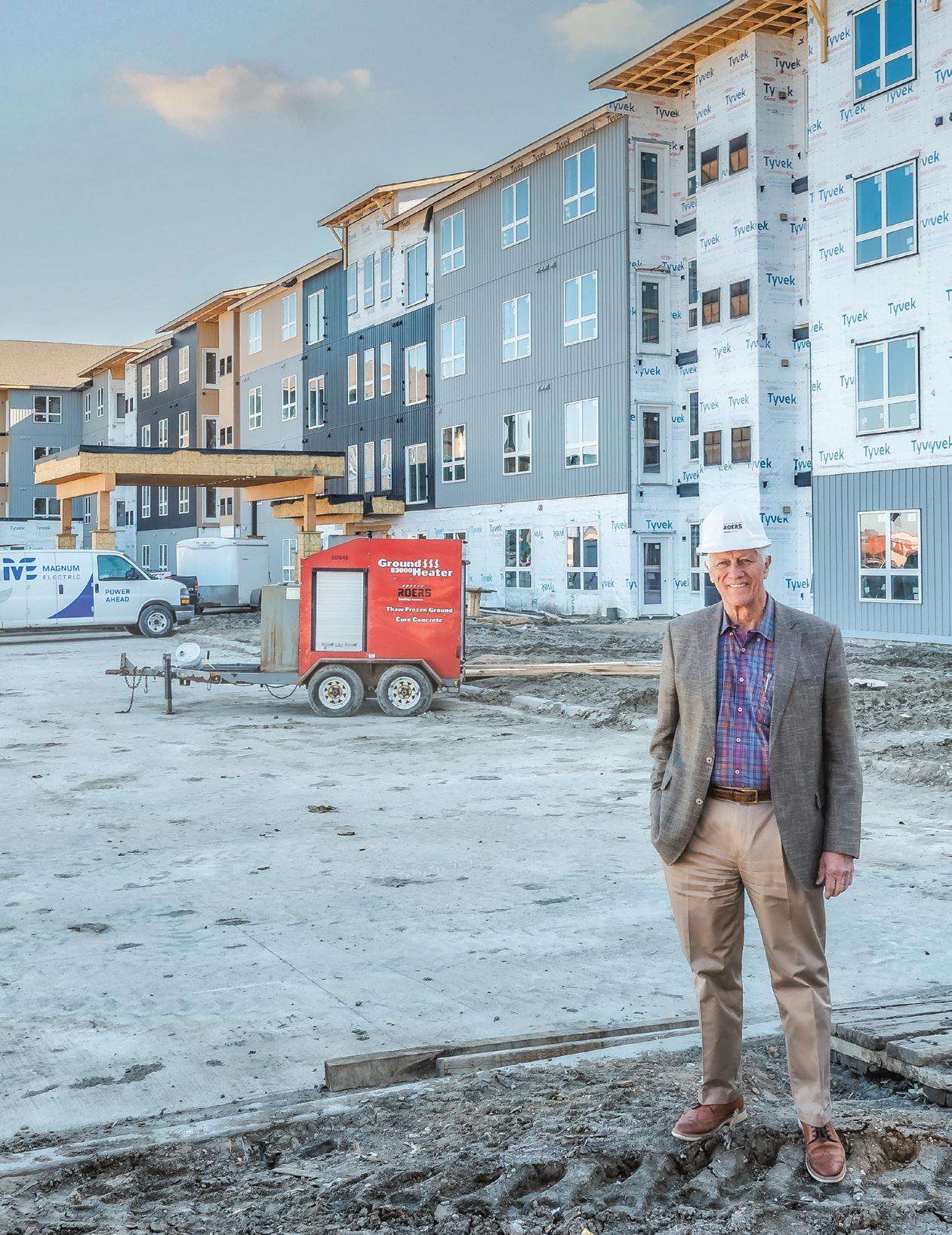
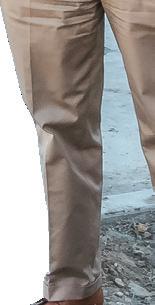
Meet Champion Venture Partners An Update on Wonder
TEDxFargo Preview
Fund North Dakota
beginning
monthly commercial content PG.100 PG.90 PG.72
2024
Developer Jim Roers
The
of our
JUNE




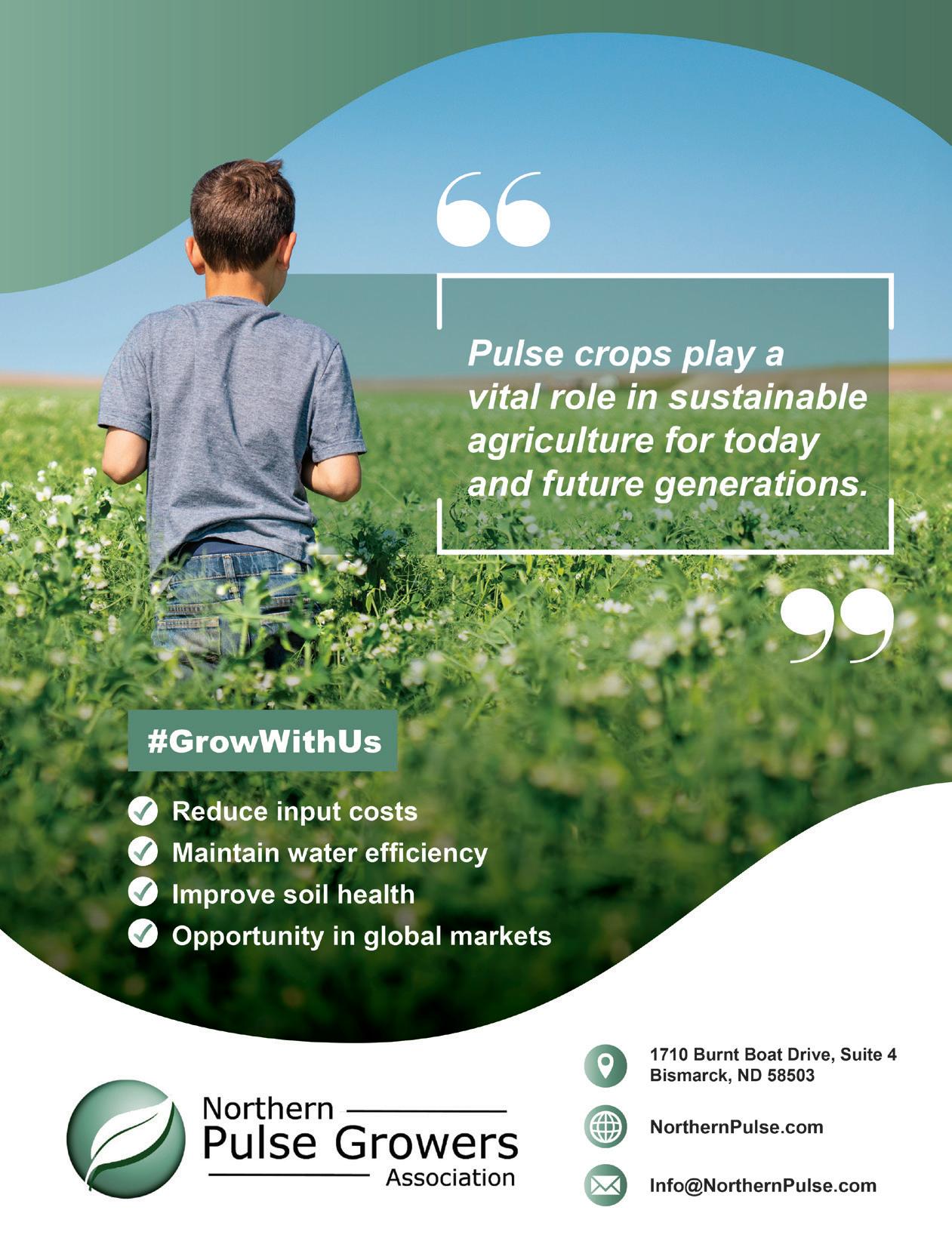


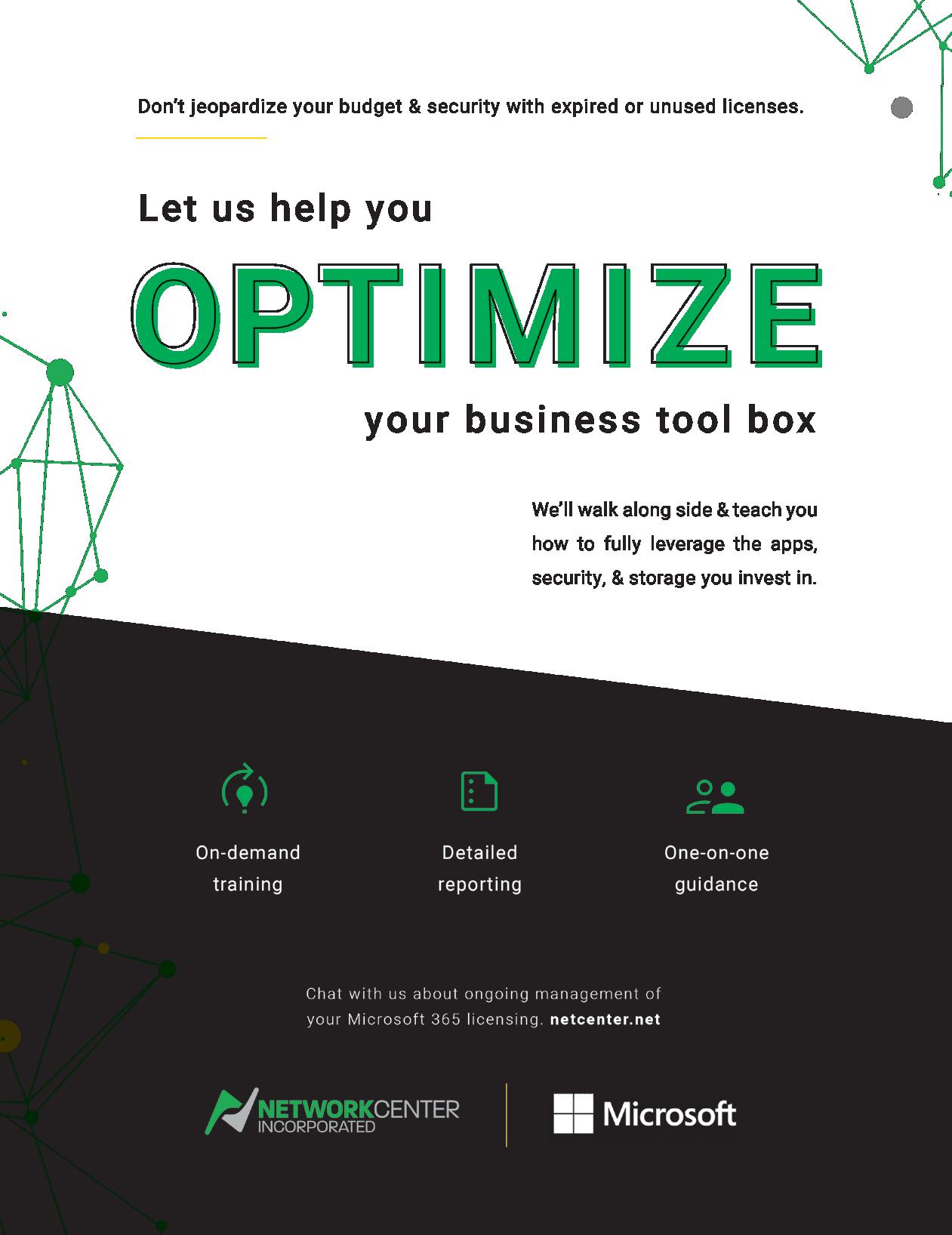


Partner Content:
The Brandt Family
Partner Content: Build With Confidence
Partner Content:
Positive Community Impact Through Innovation
The State of Space
The FMWF Metro Market Overview
Meet the Developers: Jim Roers
Meet the Developers: Mike Allmendinger
Commercial Real Estate Advice with Jay Nelson
TEDxFargo 2024
An Update on Wonder Fund North Dakota
Create the Perfect Office Fitup
Meet Champion Venture Partners
Artificial Intelligence: Where Are We Now and Where Are We Going?
The Enforceability of Handshake Agreements
Awesome Foundation Grant Award Winner: The Tell
Women You Should Know: Tiffany Hunt
10 Questions with John Machacek: Tate Howe (Get Coffee'd)




20 26 30 40 41 46 58 64 72 90 94 100 110 116 120 122 124 // JUNE 2024 72 40 94 FEATURES







FARGOINC.COM CHECK OUT All our stories in one place Business events calendar Read all the past issues Extra video content

The Commercial Real



Editor’s note
Estate Series



fargoinc@spotlightmediafargo.com

 Brady Drake, Fargo INC! Editor
Brady Drake, Fargo INC! Editor





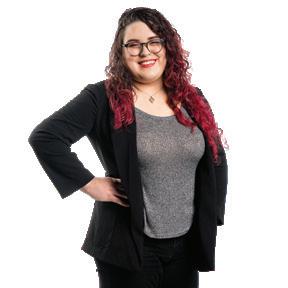







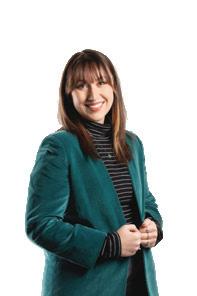





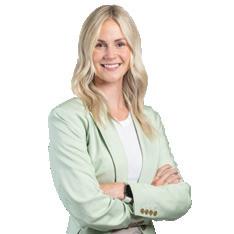



MEET THE TEAM. LEARN MORE ABOUT US AT SPOTLIGHTMEDIAFARGO.COM 14 JUNE 2024

ASK THE EXPERT



Mike Dragosavich
Brady Drake Brady@SpotlightMediaFargo.com
Geneva Nodland, Grant Ayers
Kim Cowles
Ty Betts
Josiah Kopp Ladyboss Lifestyle, John Machacek, Doug Sanzone, Lee Grossman, Brandi Malarkey, Leah Peterson Nick Schommer

Paul Hoefer Paul@SpotlightMediaFargo.com
Sam Winter Sam@SpotlightMediaFargo.com
Al Anderson Al@SpotlightMediaFargo.com
Tori Helland Tori@SpotlightMediaFargo.com
Dave McSparron Dave@SpotlightMediaFargo.com
Austin Cuka AustinCuka@SpotlightMediaFargo.com
ClientRelations@SpotlightMediaFargo.com
Jenny Johnson
Jessica Mullen
Miranda Knudson
John Stuber
JUNE 2024 Volume 9 Issue 6 Fargo INC! is published by Spotlight LLC, Copyright 2024 Fargo INC! & FargoInc.com. All rights reserved. No parts of this magazine may be reproduced or distributed without written permission of Fargo INC!, and Spotlight LLC, is not responsible for, and expressly disclaims all liability for, damages of any kind arising out of use, reference to or reliance on such information. Spotlight LLC, accepts no liability for the accuracy of statements made by the advertisers. Spotlight, LLC 4609 33rd Ave S Suite #304 Fargo, ND 58104 or info@spotlightmediafargo.com ADVERTISING: 701-478-SPOT (7768) Fargo INC! is published 12 times a year and is available at area businesses and online at FargoInc.com. Publisher EDITORIAL Editorial Team Lead Editors Art Director Editorial Graphic Designer Creative Strategist
INTERACTIVE Business Development Manager Business Development Associate Director of Creative Strategies Graphic Designer Web Developer ADVERTISING VP of Business Development
Manager Sales Representative Sales & Marketing Advisor Senior Business Development Representative Business Development Representative Client Relations Client Relations Manager
Coordinator Operations Assistant DISTRIBUTION Delivery
Contributors
Sales
Marketing
Kellen Feeney Megan
Ben Buchanan Austin Smith
Suedbeck


CHECK OUT
SPOTLIGHT MEDIA'S OTHER PUBLICATIONS


Fargo Monthly is an award-winning publication dedicated to highlighting Fargo-Moorhead and what makes it a truly enjoyable place to live.
fargomonthly.com facebook.com/fargomonthly X: @fargomonthly Instagram: fargomonthly

Future Farmer is our farming publication which brings great tech-focused content to readers across North Dakota and Minnesota.
futurefarmermag.com facebook.com/FutureFarmerMag

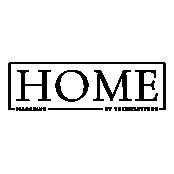
Home by Trendsetters Magazine is dedicated to covering all of the beautiful homes, home trends, and amazing professionals driving the industry forward.
@homebytrendsetters /HOMEbyTrendsetters


Bison Illustrated is your number one source for all of the behind-the-scenes action inside the North Dakota State University Athletic Department.
bisonillustrated.com facebook.com/bisonillustrated X: @bisonmag Instagram: bisonillustrated


You may already be familiar with our Faces of Fargo-Moorhead-West Fargo publication which we publish once per year in order to highlight the faces behind all of the great businesses in the community.
Are you in need of a new career? The Great Places to Work Fargo-MoorheadWest Fargo Annual Career Guide highlights amazing businesses in the area that provide great growth opportunities, benefits, and more!
18 JUNE 2024

ithout the Brandt family, the FargoMoorhead area would not be what it is today, that much is clear. But despite the family's role in developing the place we call home into what it is today, many don't know the family story.
The story truly began in 1960 when Larry and Karen Brandt moved from Minnesota to Hickson, ND after purchasing a 640acre plot of farmland from Concordia College that stretched from what is now 0.5 miles south of 32nd Ave, 0.5 miles north of 32nd Ave, and from 45th St. to Veteran's Blvd in West Fargo. In reality, things started sooner than that; however, Larry was a longtime agribusinessman. The move to North Dakota was a big one, he was the only one from his family to make the jump across state lines from Minnesota. That same year, Ace Brandt was born.
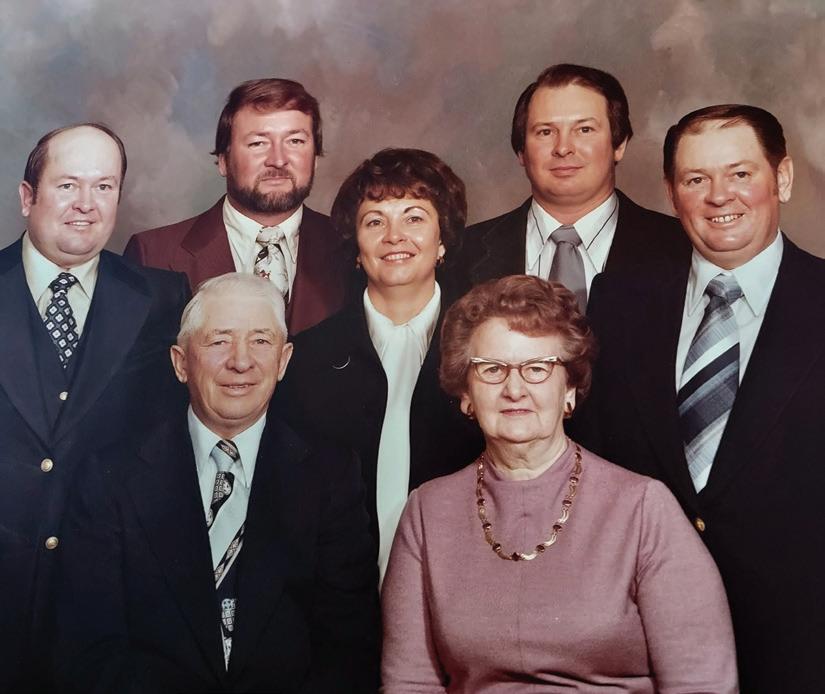
The Brandt Family
64 Years of Shaping Fargo Moorhead
By Brady Drake

PARTNER CONTENT
The Brandt family | Submitted by Tyler Brandt
1960 1960 1969 1970
Larry and Karen Brandt move to Hickson, ND
20 JUNE 2024
Ace Brandt is born Tyler Brandt is born Larry purchased 160 acres of land which is now home to the Sanford Sports Complex
And nine years later, Tyler Brandt was born. "Growing up on the farm was awesome," said Tyler, who, like his brother Ace, graduated from Kindred High School. "We didn't have cell phones. We would get on our motorcycles and take off in the morning. We'd be down by the river throwing rocks or making a jump somewhere for our motorcycles. Then, we would come home crying because we'd get hurt. We'd leave in the morning and try to get back before dark. There were lots of pickup football games and things like that. It was a good time."
In between the bumps, bruises, and boyhood shenanigans, Ace and Tyler spent time working on the farm. Tyler would go on to work on the farm in the summers through his graduation from college.
Both sons had to grow up quickly after their father passed away from a battle with cancer in 1979. At the time, Ace was 18 and promptly had to take over the daily operations of the family farm.
From there, Ace began expanding his business efforts, and in 1987, Ace purchased into the Kindred John Deere dealership with RDO.

In 1991, Tyler graduated from Concordia College, and the brothers prepared to go full throttle with their business efforts. Brandt Holdings Company was founded the following year, and Ace, who who passed away in 2021, continued working to acquire John Deere dealerships, eventually amassing 38 locations throughout the Midwestern US. Ace also acquired two John Deere engine distributorships in the Midwestern US, and another five locations in Western and Central
Canada. Meanwhile, Tyler began selling cars and heavy equipment, building experience for their next move. That move came in 2001, when Tyler partnered with Ace to start NYNE Equipment, a Vermeer Equipment dealership that did business in New York and a seven-state area in New England. Ace stayed home to manage the John Deere dealerships and Tyler moved out East for 12 years to do boots-on-the-ground sales.



1977 1979 1987 1991
Foreign exchange student and Tyler Brandt on the family farm | Submitted by Tyler Brandt
The 640 acres of "Concordia Land" is purchased by Larry
Larry Brandt passes away
Ace buys his first John Deere dealership
FARGOINC.COM 21
Tyler graduates from Concordia College
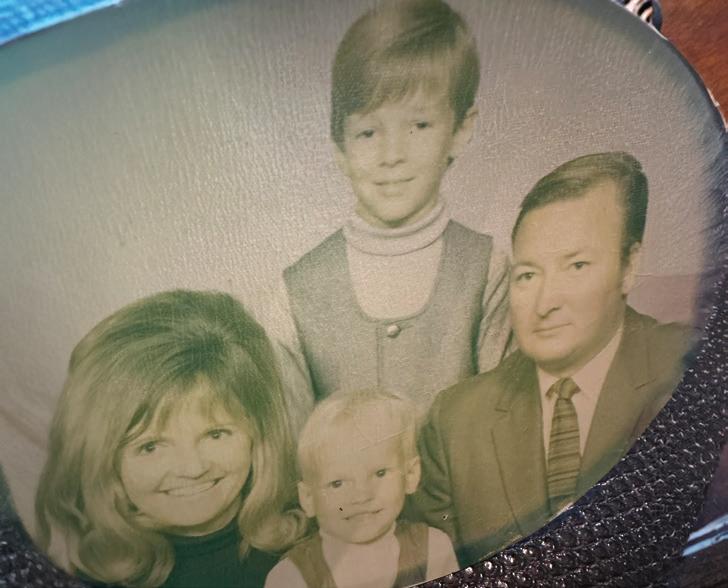
"At the time, we had three children, and we picked everything up and moved to Albany, NY," Tyler said. "We did that just before 9/11. The kids started school in August, and then 9/11 happened. That was a culture shock with that happening and us being a world away from North Dakota. Our kids were young and I was traveling across seven states. I was in my car, putting on lots of miles, and selling Vermeer Equipment. I was busy, but I always knew, no matter
what happened out there, I had the land to fall back on. I used to call it my Linus blanket."
That period of his life allowed Tyler to learn. He was exposed to different businesses in different industries and several different opportunities, and could see what works and what doesn't.

"I was the little brother, so it was not always easy," Tyler said. "But Ace was in Fargo, and I was in Albany, so we weren't working in the same office every day—that helped—but he was my partner. I had to be given numbers and understand what my numbers were—I learned real quick how to read a financial statement and how to do a SWOT analysis. I was learning on the fly, but it helped to be representing good products."
Though Tyler knew he would move back home at some point, which he eventually did in 2010, he didn't know when that would be.
"Back when I was in New York, I knew at some point I'd always be coming back here, but I didn't know when—the timing had to be right," Tyler said. "My dad, before he died, thought that the 'Concordia Land' was going to be developed in the '80s. It didn't happen until 40 years later. We always thought it was going to happen quicker, but development goes slow, and then when it takes off, it usually goes quick."
In 2008, Ace began the process of developing the "Concordia Land" with the Urban Plains Center, now named SCHEELS Arena.


1991 1992 2000 2000
Ace and Tyler hire a farm manager to run the family farm
Ace forms Brandt Holdings
Ace and Tyler stop farming and rent their land to their cousins
Ace and Tyler sell a plot of land that is purchased by the ownership group for the 52nd Ave Walmart in Fargo
PARTNER CONTENT
Karen, Ace, Tyler, and Larry Brandt | Submitted by Tyler Brandt
22 JUNE 2024
Tyler started using his skills as a developer in 2012 when a building, which is now home to Wanzek Construction, was built for a since-sold business called TMI Hospitality.
"The owner of TMI Hospitality said to me, at the time, that he was going to be all alone out here. I told him, 'It won't take long,'" Tyler said.
Since then, the "Concordia Land" has seen retail, housing, and commercial flourish. This land is now home to The Tavern Grill, Hair Success Salon, Spa & MediSpa, and the EagleRidge Plaza and so much more.
"It's kind of interesting how development goes," Tyler said. "It typically goes really fast. First, people started focusing on building out towards 52nd Ave, but then, all of a sudden, everything kind of came back. People seem to want to stretch the edges of town and then developers infill."
Since then, Tyler has had his hand in shaping a large portion of South Fargo. Alongside other investors, he has helped bring Suite Shots, Kingpinz,
the Sanford Sports Complex, and dozens of other projects to completion.
"When you drive around town, you see things that went well and you also see the things that didn't go so well," Tyler said. "It also brings you back to when you did those things. I also have found that I look at architecture in a completely different way since I've become a land developer. I want to be proud of what I've built. I want my grandkids to drive by and say, 'Grandpa built that.' Even though he's not here, I want my dad to be proud of me. I'm proud of what we've done so far. I want to continue to bring new and different things to Fargo in order to make it a place that people want to move to and live in."
In doing so, Tyler says he plans to continue expanding toward 100th Ave, the cutoff for The FM Area Diversion.
"We're always looking at new entertainment-type facilities and food venues," Tyler said. "We're always looking for people who have a vision—the people who want to grow their business."

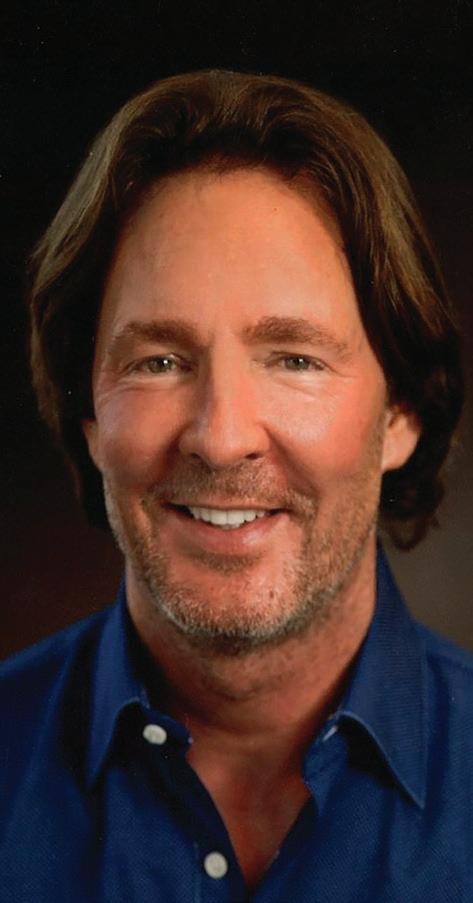



2001 2008 2012 2019
Ace Brandt Submitted by Tyler Brandt
Ace and Tyler partner to start NYNE, a Vermeer Equipment dealership operating in New York and seven New England states
Ace begins developing the Urban Plains area
The TMI Hospitality building is constructed
FARGOINC.COM 23
Media Shack is founded by Spencer Brandt

In his efforts to do that, Tyler joined the Property Resources Group team in 2010, where he works as a Commercial Agent to help his clients find the best spots for their businesses.
And he isn't the only member of the family with business savvy. His son Tanner works for Christianson Companies a sister company of Property Resources Group. His daughter Chelsea is an associate attorney at Gebhardt Emerson Moodie Bonnanno LLC, and his other son Spencer founded Media Shack in 2019, a company specializing in embroidery, screen printing, vinyl graphics, graphic design, and corporate branding.
Only time will tell what is next for the Brandt family, but we know the FargoMoorhead area will be there to see it.





Tyler Brandt Office: 701-356-8888 Direct: 701-499-3905 tyler@prgcommercial.com
PARTNER CONTENT 2020 2021 2022 2024
Tyler Brandt is currently a Commercial Agent/Owner with Property Resources Group in the Commercial Sales & Leasing Division. | Josiah Kopp
Ground Breaks on Suite Shots and Kingpinz
Ace Brandt passes away
Ground breaks on Sanford Sports Complex
24 JUNE 2024
Sanford Sports Complex opens Geneva Nodland

BUILD with Confidence
Since 2011, Enclave’s transformed into a full-service real estate firm that exists to create spaces where people thrive. Their unified team with in-house development, construction and management has helped shape the community they call home and is leaving a lasting impact on communities across the Midwest and Mountain West.
At its core, Enclave offers investment opportunities that are brought to life through a 360° business model. Using their unique perspective as a co-investor, owner and long-term holder of real estate assets, Enclave builds healthcare, industrial and commercial spaces that prioritize client vision, budget and schedule.
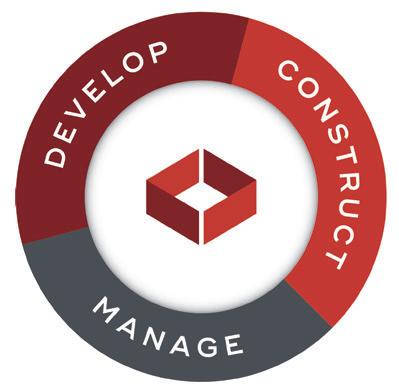

When clients choose to build with Enclave, they benefit from more than just our expertise and assurance as a general contractor. We leverage our experience as building owners and operators, tapping into the collective knowledge across teams to provide valuable insights on site selection, operating efficiency and cost-effective solutions.
Eric Christianson Chief Operating Officer
PARTNER CONTENT
26 JUNE 2024
Enclave’s dedication to quality and customer satisfaction was evident in every interaction, and their ability to deliver on-time and under budget exceeded our expectations.
Dr. Michael Greenwood Vance Thompson Vision

Construction Experts Built for Every Project
With 150+ projects built, spanning over 9 million square feet, Enclave’s team approaches each project with a commitment to align with a client’s vision and provide frequent and transparent communication. Whether building from the ground up or upgrading a current space, Enclave acts as a steward of your investment by listening, exploring all options, advising and executing according to plan.
“We view client and partner success as our success, and our team executes in pursuit of total client satisfaction through proactive communication, planning and attention to detail.”
Jeremy Cossitt, Director of Construction
Recognized for Quality, Safety and Innovation
Projects like Center for Special Surgery, Vance Thompson Vision and Sign Solutions USA exemplify Enclave’s award-winning approach. Both Center for Special Surgery and Sign Solutions USA were recognized as being best-in-class for their solution-first mindset, quality craftsmanship and ability to exceed timeline, budget and safety requirements.
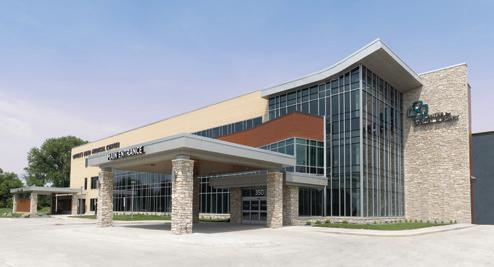
230+
Team Members
9M+
Total SF Constructed
150+ Successful Projects
5,500+ Units Managed
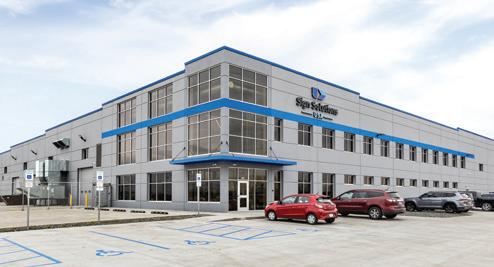
enclavecompanies.com Let’s
Your Space
Partner on
FARGOINC.COM 27

JBC Commercial Real Estate is the leading commercial property solutions provider in the Fargo, ND region offering sales and leasing brokerage, development, and advisory services. JBC Commercial Real Estate was formed in August 2019 by two long-time veterans of the regional commercial real estate industry, Jim Buus and Lori Ibach. The two have a combined 50+ years of commercial property experience. JBC Commercial consists of a diversified team of professionals ready to be your resource.
The JBC Commercial team provides property owners full-service brokerage services to sell or lease their property and site selection services to buyers or tenants. They consistently strive to be a comprehensive resource for pricing, market assessment, marketing, and closing transactions. JBC's full-service consulting and advisory services include strategic planning related to business growth and transition, facility planning, specific project consulting, investment partnerships, and other collaborative ventures.

Commercial Real Estate
As a business owner or manager in need of new commercial space, it's important to get professional help by picking a commercial REALTOR® you feel comfortable with. It's typically not a good plan to simply do your own research or drive around calling off signs or working with multiple agents. Find and commit to working with one commercial REALTOR®.
ASK THE EXPERT
What You Need To Know About Searching For
Josiah Kopp
28 JUNE 2024
Logan Carney, Michelle Novak, Jim Buus, Lori Ibach, Brent Kuehne, Brittaney VanderHagen, Karsten Broadley
Understand how your commercial REALTOR® gets paid. In most cases, your REALTOR® is paid a commission from the landlord or seller, so the services provided by the REALTOR® you choose to work with don’t directly cost you anything. Therefore, don’t be hesitant to find and retain a REALTOR® you trust and let them do their job to represent you and negotiate a good deal for you.
Make sure you understand who is representing who in the transaction. When a REALTOR® has their sign on a property they are the “listing agent," it and it means they are representing the landlord or seller, not you. While the listing agent is still obligated to act fairly and ethically to you as the prospective tenant or buyer, they are technically trying to get the best deal for their owner or seller.
Buying versus leasing. It is very common for commercial transactions to be a lease, not a sale. Leases typically go for three to five years but can be shorter or longer. Many businesses prefer not to own their property for a variety of tax, financial, or personal reasons. So it's important to have a commercial REALTOR® you trust to assist with the complexities of negotiating lease terms and advising on language and your general interests. It's also quite common to additionally seek advice from an attorney on lease language and your rights as a tenant.
Allow for plenty of time for the overall process. It's common for the process of searching, identifying, and acquiring your new property to take six months or more especially if the property involves a lot of construction or remodeling. As a business owner, you need to constantly be aware of your business's strategic and specific needs relating to real estate so you can plan accordingly.

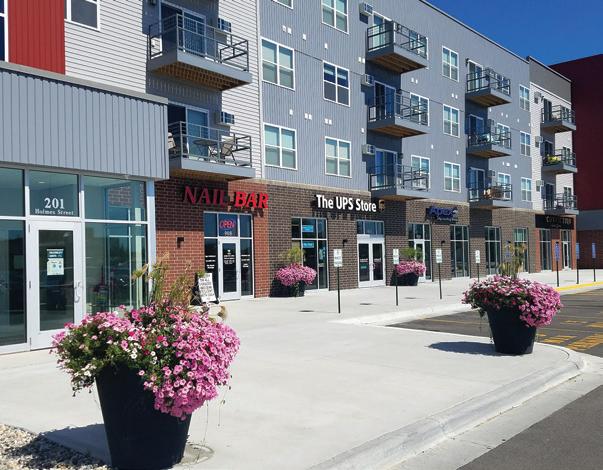
If you are unable to find an existing property that meets your needs, you may wish to acquire land to build on and/ or engage an investor developer to build a new facility and lease it back to you. The JBC Commercial team is experienced in all aspects of the real estate development and construction process and can assist with building a new facility, owning it, and leasing it to your business long term.


Contact Jim Buus at JBC Commercial jim.buus@jbccommercial.com 701-929-6000
Do you need a brand-new facility built for you? FARGOINC.COM 29
POSITIVE COMMUNITY IMPACT THROUGH INNOVATION
AND A ROBUST COMPANY CULTURE
How Houston Engineering, Inc. is Leading the Way in Industry Excellence and Workplace Culture
By Josiah Kopp

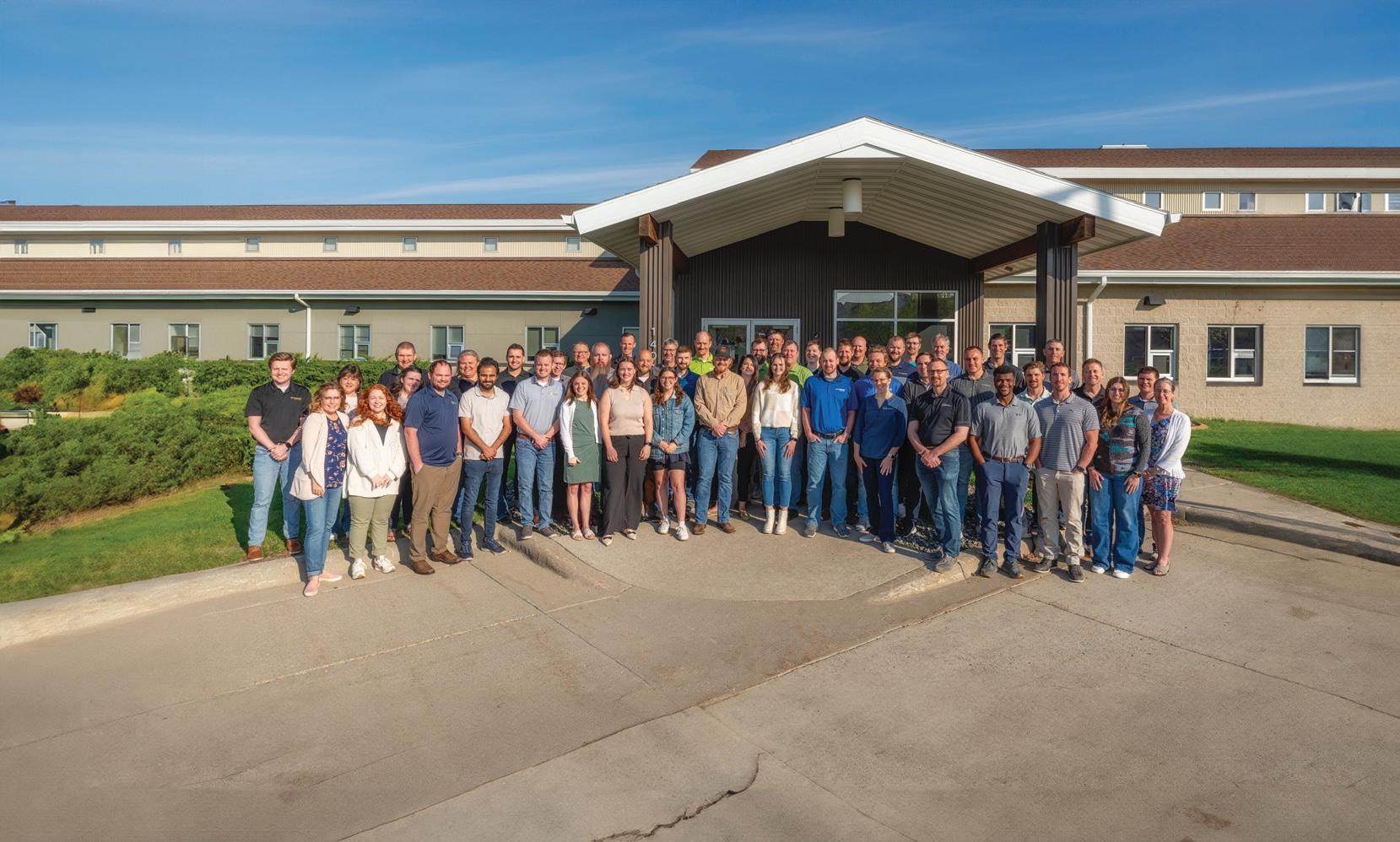
tarting as a small business providing surveying, municipal engineering, and site development services in North Dakota, Houston Engineering, Inc. (HEI), founded by George Houston in 1968, has evolved into a thriving engineering company with more than 250 professionals across five states, significantly impacting Fargo and beyond. Over 55 years later, President and CEO Gregg Thielman is leading HEI as the company continues the legacy, building both lasting structures in the community and a lasting culture internally. We had the privilege of sitting down with Thielman to discuss HEI's culture, vision for the future, and more.
PARTNER CONTENT // Geneva Nodland
30 JUNE 2024

AN AWARD-WINNING TEAM
Prairie Business Magazine has listed HEI among the best places to work every year since 2014. This award is based on employee votes, demonstrating the dedication and pride of the HEI team.
At its core, HEI is a talented group of engineers, scientists, technicians, surveyors, programmers, and support staff that work to improve the communities in which they live and work. In doing this, HEI works to ensure that they provide practical and efficient solutions to solve community needs.
HEI functions in six main business sectors: water resources, transportation, municipal infrastructure, environmental, geospatial technology, and surveying and reality capture. Water resources is its largest sector, which includes work for watersheds, flood control, and stormwater modeling. HEI also has an environmental group that specializes in both water quality and environmental permitting, wetlands, delineations, and more. HEI has a growing transportation group that includes designing roads, bridges, railroads, and other infrastructure projects.
"Our Mission is to make positive impacts to communities through collaborative partnerships and innovation," Thielman said. "We've been involved in transformational projects for our clients, including the Fargo-Moorhead Area Diversion Project from the start. Our work includes designing levees, floodwalls, and roads in the area. Our growing footprint includes undertaking flood control in Minot and the Northwest Area Water Supply and Distribution project. These projects will benefit future
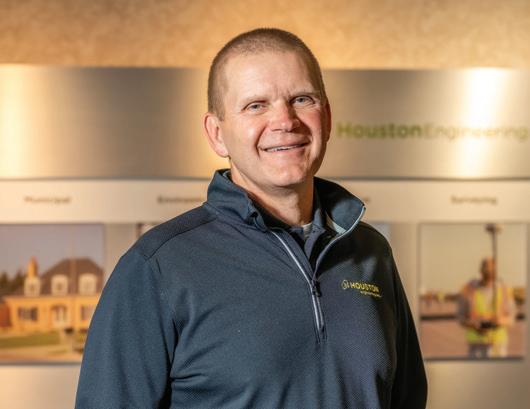
generations. Additionally, in the Twin Cities, we work on climate resiliency and environmental enhancement projects, serving our clients now and in the future."
WHAT SETS HEI APART
HEI puts themselves on the cutting edge of technology by monitoring, exploring, and implementing new technologies like reality capture, augmented reality, and AI. They push industry-standard software to new heights through innovative uses of CAD and GIS, making it easier than ever for users to parse, access, and implement data.
Yet HEI strives to go the extra mile and offer even more to the clients they serve. "We have in-house software engineers that develop software solutions that not only make us more efficient but also serve our clients," he said. Notably, they developed the ND Roads web and mobile applications for the North Dakota Department of Transportation—an app that is critical for North Dakota travelers to stay up to date on the latest road conditions. HEI also combined their software engineering and environmental expertise to develop MS4Front and DrainageDB, which are now used by county, municipal, and watershed clients throughout the country.
ABOUT GREGG THIELMAN
Before joining HEI, Thielman worked for the North Dakota Department of Water Resources for seven years. He had a connection at HEI through Lawrence Woodbury, who was the President and CEO at the time. Woodbury, who happened to be one of Thielman's college professors, offered him an opportunity to come to HEI to work in water resources and on other exciting projects. "I've appreciated the opportunity I've had to grow in my career, increasing responsibility, and eventually moving into the role that I now have as President and CEO," Thielman said.
CONTINUED
FARGOINC.COM 31
Josiah Kopp
All of HEI's locations
DID YOU KNOW?
HEI works in six primary sectors:
Water Resources Transportation
Municipal Infrastructure
Environmental
Geospatial Technology
Surveying & Reality Capture
SUCCESS & ACCOMPLISHMENT WITHIN HEI
The difference between a job and a career is how well a company takes care of its team, and HEI is an industry leader when it comes to building a thriving workplace. Its approach to success and accomplishment within the organization is through building a strong and equipped team, providing great compensation and benefits, and investing in a lasting culture.
growth training, or developing soft skills. But we provide the resources that you need to advance and grow in your career."
LOOKING AHEAD: THE FUTURE IS BRIGHT FOR HEI
Currently, HEI is in the midst of a strategic planning process, setting its course for the next 3-5 years—and Thielman says the future of the company is looking brighter than ever. "It's exciting to hear all the ideas that our staff have for where we want to go, where we want to take our skill set, and how to grow our skill set. There's a lot of opportunity for us and the sky's the limit." Building the collective vision and framework for the future of the company shows how HEI is invested in their team and their culture.

One core value of HEI is to be the ideal team player, which Thielman says is inspired by the book The Ideal Team Player: How to Recognize and Cultivate The Three Essential Virtues by Patrick Lencioni. This core value is a building block that helps set team members up for success while providing continual opportunities for career growth and development.
"It starts with having really good resources available within the company. As you come onboard, you have mentors who work with you to develop your skill set," Thielman said. "But then we also have external training opportunities that we send people to, whether it's more technical training,
Recently, HEI expanded their footprint with offices in Omaha, Lincoln, and Des Moines. "I see us continuing to look for opportunities to grow," Thielman said. HEI's technology group is already serving clients nationwide, and Thielman sees that as an open door for more growth as HEI advances into the next chapter—and that's his ultimate objective—to "position ourselves to achieve goals," as he said it.


PARTNER CONTENT // Josiah Kopp
32 JUNE 2024

HEAR FROM TEAM MEMBERS
 JERRY BENTS
Fargo Office Manager
JERRY BENTS
Fargo Office Manager

How did you first discover HEI?
While I was studying pre-engineering at NDSU, I was looking for summer internships and had the opportunity to work for several different firms in Fargo Moorhead, including HEI. I loved the family culture of HEI. I interned for two more years and then joined full-time in 1997—it's over 25 years later and I've been here ever since.
When did you realize they were a great fit for you?
Truly, right away. Like I said, HEI had a different feel to it—a lot more of that family feel. I felt like they were genuinely interested in me and in my success, as opposed to someone coming on to just fill a role.
What's one specific example of how HEI has shown you they're invested in you as a team member?
HEI supports annual training and courses, some of which are required to keep up with your licensing. But HEI also provides a lot of opportunities if they want to explore new markets by attending national conferences and getting a view of what that market would look like and how to enter it.
If you could summarize, how would you say HEI is a great place to work?
You're treated with respect and you're treated as a professional. There are expectations for you to contribute to the team, while at the same time, you're rewarded well for your contributions, and for supporting the success of our clients and company.
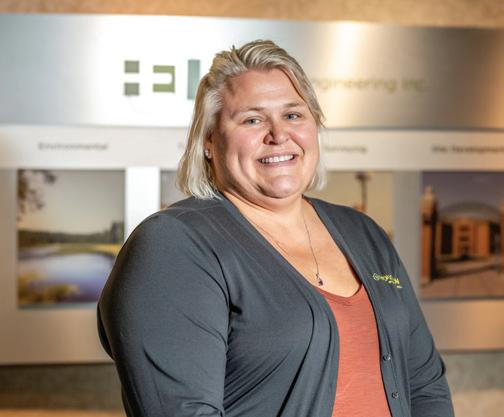
KRISTEN LOTVEDT
Civil Engineer
How has HEI helped you grow in your role?
HEI has helped me grow in my role here by having me join the Fargo Moorhead West Fargo Chamber Leadership Group, which I did a few years ago. Through that, I met several people who I still have contact with today. HEI also nominated me for Prairie Business Magazine's 40 Under 40, which I received a couple of years ago. HEI shows that they view me as a valued employee and thinking that I'm doing good work is justification for me to keep going and striving to do better.
What are some of the key benefits of working for HEI that you love most?
Flexibility: Given that I have three kids, there are times you have to take time off, and HEI is very flexible as long as you get your work done, so that is something that I've very much appreciated. Working from home: Similarly, if I need to work from home because my kids are sick, they're very accomodating to that. Employee appreciation: The interest they show in their employees by doing fun things like barbecues in the summer, holiday parties, or celebrating a big project is something I think is fantastic.
What do you think a lot of companies miss that HEI gets right with their team and employees?
HEI trains its employees well enough to go to work for other people but treats them well enough that they want to stay; there are a lot of employees who have been here for 20-plus years.
CONTINUED FARGOINC.COM 33
WHY WORK FOR HOUSTON ENGINEERING?
"We're a great place to have a career. When we hire people, we look at them as career employees. Oftentimes, we'll hire someone right out of college, and they'll work here for their full career. We provide opportunities for them to advance throughout their career, challenging opportunities, as well as good teammates, and we have fun while doing it."
- Gregg Thielman, President/CEO
HEI just launched their all new website! Scan the QR code to check it out!
Visit their careers page at houstoneng.com/careers to learn more about career opportunities at HEI.
houstoneng.com /houstoneng @houstonengineeringinc /houston-engineering-inc /houstoneng


PARTNER CONTENT // Josiah Kopp JOIN
HOUSTON ENGINEERING TEAM!
THE
DID YOU KNOW?
34 JUNE 2024

 By NorthStar Technology Group
By NorthStar Technology Group
today’s digital age, most businesses rely heavily on technology to streamline their operations and stay ahead of the competition. However, managing an entire IT infrastructure in-house can be overwhelming and expensive.
That’s where outsourcing IT services comes into play. By partnering with a reliable and efficient outsourced IT provider, you can offload the complexities of managing your technology infrastructure and focus on your core objectives.
However, with a myriad of IT service providers in the market, how can you ensure that you choose
the right one for your business? In this article, we’ll take you through a few important things you should consider when browsing for an outsourced IT partner. By clearly understanding what to look for, you can make an informed decision and find a partner that aligns with your organization’s goals and requirements.
Factors to Consider
Here are a few key factors to keep in mind before you commit to an IT partner:
Cultural Alignment
Choosing an IT service provider that aligns closely with your organization’s culture is crucial for a successful partnership. Cultural alignment means the IT service
ASK THE EXPERT 36 JUNE 2024
provider shares values, work ethics, and communication styles with your business.
With a strong cultural fit, the collaboration becomes seamless, and both parties can work together more effectively. This alignment enhances communication, trust, and mutual understanding, leading to smoother project implementation and better results.
By selecting an IT service provider that understands and respects your organizational culture, you can foster a productive working relationship and achieve your IT objectives more efficiently.
Vested Interest and Industry Knowledge
A reliable IT service provider should demonstrate a vested interest in your organization’s success. This means they are genuinely invested in building a long-term partnership and are committed to understanding your business goals and challenges.
The IT service provider should also possess industry knowledge and experience relevant to your specific sector. This understanding allows them to provide tailor-made IT solutions that address your unique needs.
By partnering with an IT service provider with a genuine interest in your success and industry expertise, you can benefit from their insights, strategic guidance, and proactive support. Their knowledge of industry best practices can help you navigate technological advancements and make informed decisions that drive your business forward.
References and Value Demonstration
When evaluating potential IT service providers, it is essential to seek references and ask for evidence of the value they have provided to their clients. Speaking with their current or past clients allows you to gain valuable insights into their performance, reliability, and customer satisfaction.
Requesting real metrics and use cases enables you to assess the IT service provider’s track record and evaluate how their services have benefited other businesses. This information gives you confidence in their capabilities and helps you gauge how suited they are for your organization.
By choosing an IT service provider with positive references and a demonstrated ability to deliver value, you can minimize risks and make an informed decision that aligns with your business goals.

Round-the-Clock Service
Technology disruptions can occur anytime, and prompt resolution of IT issues is crucial to minimize downtime and maintain business continuity.
An IT service provider offering round-the-clock service ensures that technical support and assistance are available whenever needed. This 24/7 support can be crucial if you operate across different time zones or have critical operations outside regular business hours.
By partnering with an IT service provider that provides continuous support, you can have peace of mind knowing that any IT issues will be addressed promptly, reducing the impact on your operations and enabling your business to run smoothly without interruption.
Act Before It’s Too Late
Ready to find the perfect IT service provider for your business? Don’t wait any longer—reach out to NorthStar Technology Group today and schedule a no-obligation cyber strategy session.
northstartechnologygroup.com /NorthStarTG 866-337-9096 @NorthStarTechno @NorthStarTechno Our team of experts is eager to understand your unique needs and discuss how our services can help your organization thrive. FARGOINC.COM 37
FAQS ABOUT COMMERCIAL REAL ESTATE
By Drew Likness, Director of Sales

What local funding incentives are available?
The city, state, and local organizations offer a multitude of funding incentives available for businesses. Some incentives include the ND Child Care Loan Program, the North Dakota Development Fund, and Renaissance Zone tax incentives. It’s important to check with local economic development professionals, whether you are purchasing or leasing commercial property.
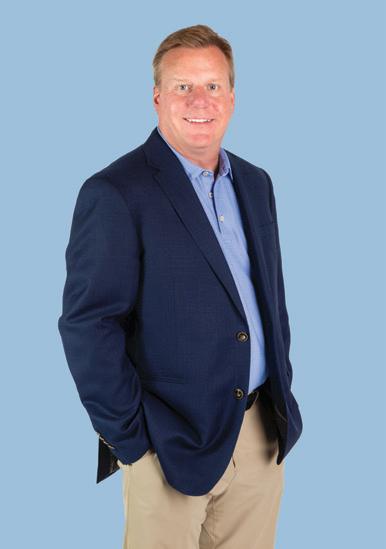

What is CAM?
CAM (Common Area Maintenance) is an additional fee on top of the base rent that covers routine charges to maintain the common areas shared with other tenants. It also includes the tenant's pro rata share of maintenance items such as lawn care, snow removal, building insurance, and real estate taxes.
ASK THE EXPERT
provided by EagleRidge Development
EagleRidge Plaza - Fargo, ND
Commerce at The Grand - Fargo, ND
38 JUNE 2024
Geneva Nodland

What is a commercial fit-up and a TIA?
Commercial fit-up is the process of designing and constructing a commercial space, and a tenant is typically given an allowance by the landlord—which is called a Tenant Improvement Allowance (TIA). This allowance is agreed upon by the tenant and landlord as an amount that the landlord is willing to contribute to the space. The TIA is usually set per square foot or as a set total. If the improvements go above the agreed-upon sum, the tenant is responsible for covering the remaining cost.


How do I pick the right location for my business?
Location can make or break a business, so finding the right space for your business is essential. Luckily, EagleRidge Development puts a lot of research into choosing where they build their properties and has several great options for a variety of businesses. A few of them include the Northern Lights, The Standard on 32nd, EagleRidge Plaza, and Commerce at The Grand. Give us a call and we can help you find the perfect spot to grow your business!
What is an LOI?
A letter of intent (LOI) is an agreement between the landlord and tenant, or seller and buyer. The agreement is considered preliminary and outlines the proposed terms of a deal.

3280 Veterans Blvd Ste 300, Fargo, ND 701-540-7159 info@eagleridgecompanies.com eagleridgedevelopment.com Have additional questions about commercial real estate? Contact EagleRidge Development for more information.
EagleRidge Plaza - Fargo, ND
Northern Lights - West Fargo, ND
FARGOINC.COM 39
The Standard on 32nd - Fargo, ND
 By Brady Drake
By Brady Drake
By Brady Drake
By Brady Drake
COMMERCIAL REAL ESTATE SERIES
ffice space and warehousing are both crucial components of any business's operational infrastructure. Office spaces, in particular, provide a physical location where employees can collaborate, innovate, and drive the company's goals forward. The layout, location, and environment of office spaces significantly impact productivity, company culture, and employee satisfaction. In an era where businesses are continually adapting to new economic realities and technological advancements, the demand for and utilization of office space are constantly evolving. Understanding trends in office space growth and occupancy is vital for businesses to make informed decisions about their real estate investments, operational strategies, and future growth plans.
In this issue, we will be highlighting a number of things in the commercial real estate space and we plan to include commercial real estate content in most issues for the foreseeable future. Is there something you want us to cover? Email Brady Drake at brady@spotlightmediafargo.com
MORE REAL ESTATE CONTENT COMING SOON! 40 JUNE 2024
Data provided courtesy of THE FMWF METRO MARKET OVERVIEW

oming from the technology world, Andy Westby , president, managing broker, and auctioneer at Goldmark Commercial Real Estate, was stunned by the lack of data being used in the local commercial real estate world. So, he started compiling data and using it to gain an advantage.
Eventually, he and his team decided to start sharing this information with others at their annual Commercial Connect event. We were lucky enough to attend, and here are some of the interesting facts we learned along the way.
What This Means:

OFFICE SPACE BY THE NUMBERS
+ 1.1 % GROWTH RATE OF NEW OFFICE SPACE IN 2023
Note: Although there was growth of new office being built in 2023, it is the lowest growth our region has experienced since 2011. For reference, the area has experienced 13.8% office square feet space growth overall since 2019.
NEW CONSTRUCTION DOWN 35.5 % OVERALL YEAR-OVER-YEAR AFTER BEING DOWN JUST 2.5 % IN 2022
9.7% VACANCY FOR OFFICE LEASING AT THE END OF 2023
Note: Although the office vacancy rate increased from 7.6% to 9.7% from 2022 to 2023, our metro is still well below the national average vacancy rate of 19%.
As of the end of May 2024, office vacancy in the metro stands at 9.5%.
223K SQ FT OF OFFICE SOLD IN 2023 AFTER 431K IN 2022 AND 763K IN 2021
Although we have taken a hit, the numbers suggest that Fargo is still performing better than the national average. However, we are not immune to downsizing, closings, and the shift to remote work leading to higher vacancies. The decrease in the growth rate of office space in 2023 could be influenced by the increasing trend of remote and hybrid work models, which became more prevalent during the COVID-19 pandemic. Many companies might be re-evaluating their need for physical office space, leading to a slowing in office space growth. The 35.5% decline in new office building permits in 2023 should be a surprise to no one. As interest rates remain unfavorable, it's doubtful that we see much new office construction in 2024. The significant decline in office space sales, from 763,000 square feet in 2021 to 223,000 square feet in 2023 highlights the shift in market dynamics and economic conditions. Despite the challenges, Fargo's office market remains relatively resilient compared to national trends, but caution and strategic adjustments are necessary to navigate the evolving landscape.
FARGOINC.COM 41
THE FMWF METRO MARKET OVERVIEW
Data provided courtesy of
INDUSTRIAL
19% INDUSTRIAL SF SPACE GROWTH SINCE 2019
3.1% METRO VACANCY RATE AT THE END OF 2023
INDUSTRIAL PERMITS DOWN 19.6% YOY
INDUSTRIAL SALES
1.239M SF SOLD IN 2023 UP FROM 944K IN 2022
What This Means:
The industrial sector in the Fargo-Moorhead metro area has experienced significant growth, with a 19% increase in industrial square footage since 2019. This expansion reflects strong demand and a vibrant industrial market. However, industrial permits for new construction are down 19.6% year-over-year, suggesting a potential slowdown in new industrial developments.


NOTE: This is slightly up from the 2.9% vacancy rate of 2022, yet well below the national average industrial vacancy of 5.6% at the end of 2023.
As of the end of May 2024, industrial vacancy in the metro now sits at 2.5%.
NOTE: This is a 31.2% increase, with a price price per SF increase of 14.8% to boot.
Despite the decrease in new permits in 2023, the market remains active and healthy. The metro vacancy rate for industrial space slightly increased to 3.1% in 2023 from 2.9% in 2022, indicating a relatively tight market with high occupancy levels.
This slight uptick in vacancy rates might be due to new space coming online or existing businesses consolidating their operations. Through May of this year, however,
vacancy rates have dropped to 2.5% showing a strong market.
Industrial sales have been particularly robust, with 1,239,000 square feet sold in 2023, up from 944,000 square feet in 2022. This 31.2% increase in sales volume by SF demonstrates continued strong demand for industrial properties, likely driven by the area's strategic importance for logistics, warehousing, and manufacturing.
42 JUNE 2024

THE FMWF METRO MARKET OVERVIEW
Data provided courtesy of
RETAIL
+0.65% GROWTH RATE OF NEW RETAIL SF IN 2023

NOTE: This is the 2nd lowest growth since 2011. Overall, the FMWF metro has grown retail square footage by 5.9% since 2019.
RETAIL CONSTRUCTION PERMITS ARE DOWN
4.8% METRO VACANCY RATE AT THE END OF 2023
What This Means: The retail sector in the metro area is experiencing modest growth and some signs of market adjustment but remains healthy overall. In 2023, the growth rate of retail square footage was 0.65%, marking the second-lowest growth rate since 2011. Despite this slower pace, the region has seen an overall growth of 5.9% in retail space since 2019.
9%
NOTE: Retail construction permits were down 9% in 2023 after being up 81% in 2022.
NOTE: The vacancy rate was at 5.9% in 2022. As of the end of May 2024, retail vacancy stands at 4.7% metro-wide.
Retail construction permits have declined by 9% in 2023, following a significant increase of 81% in 2022. This drop may suggest a cooling in new retail development, possibly as a correction after the previous year's surge or due to changing economic conditions and market demands.
The metro vacancy rate for retail spaces decreased to 4.8% at the
end of 2023, down from 5.9% in 2022. This improvement in vacancy rates indicates a healthy demand for retail spaces, with more spaces being occupied compared to the previous year.
Overall, while the growth rate of new retail space has slowed and fewer construction permits are being issued, the decrease in vacancy rates shows that existing retail spaces are being successfully leased. While there are pockets of higher vacancy in some buildings or areas of the metro, the overall data points to a resilient retail market in the FMWF metro area.


44 JUNE 2024
 By Brady Drake | Josiah Kopp
By Brady Drake | Josiah Kopp
MEET THE DEVELOPERS
If Jim Roers didn ' t exist, the FargoMoorhead region would look much different. For over 48 years, Jim and his business, ROERS, has been involved in constructing and developing a large portion of the city and they ' re still going strong.
JIM ROERS Founder, ROERS

46 JUNE 2024

CONTINUE FARGOINC.COM 47
MEET THE DEVELOPERS
JIM ROERS


CONTINUE 48 JUNE 2024


MEET THE DEVELOPERS JIM ROERS

"Over the last 45 years, I've seen cycles go up and down a half a dozen times," Jim said. "If you go from 42nd to 45th, in that vicinity, that was an office park that everyone was clamoring to get into. If you drive through there now, you'll see a lot of dark windows. But, when it came up, there were a lot of big box users coming to town. There were call centers, and data processing centers, but all of those things are being done from home now. Technology and COVID have tipped the world upside down and it's going to take 10 to 20 years for us to regroup and repackage our inventory. Right now, you can't build new office space and make it work... We've got an oversupply of all of this inventory for retail and office. So, new buildings are going to be at a standstill. Even though there could be a demand, you can't build because today's building costs and revenue streams don't match up."
Jim and his team, who also does property management in addition to real estate development and construction, are not immune to this. Currently, they are in the process of repurposing their West 45th Street Business Center located at Second Avenue South and 45th Street in Fargo.
"That building was 97% full for 20 years. But, as a result of COVID, all my tenants terminated their leases when they came due. Now, I'm sitting 40% full. Now, I've got to repurpose that building."


A
CONTINUE
FARGOINC.COM 51
Q
ROERS WORKED ON THAT
There is no way we could show you all of the projects ROERS has worked on over the years, but you might recognize a few of these.



75,228 sq. ft.



WEST 45TH BUSINESS CENTER
22,3788 sq. ft.
 ST. PAUL NEWMAN CENTER
ST. PAUL NEWMAN CENTER
CONTINUE 52 JUNE 2024
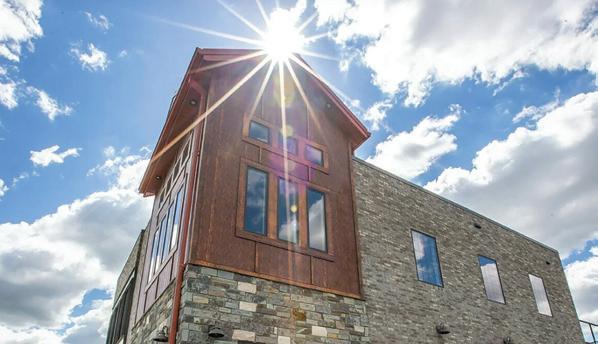

PRECISION LAWN LANDSCAPING
24,250 sq. ft.



DOOSAN BOBCAT HEADQUARTERS
11,000 sq. ft.
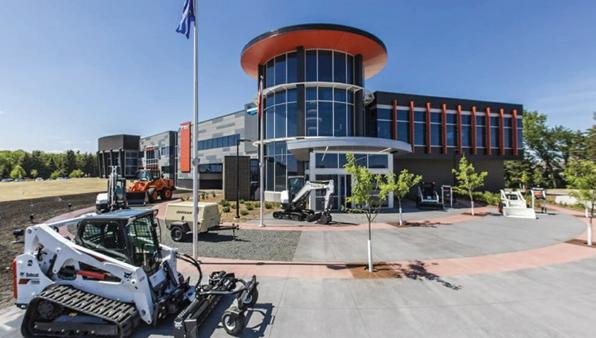
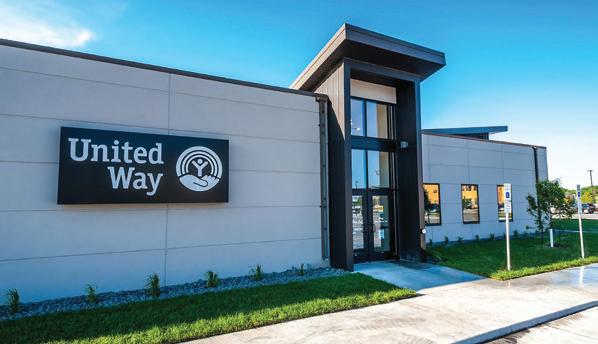

UNITED WAY OF CASS CLAY
8,000 sq. ft.

ST. PAUL NEWMAN CENTER
FARGOINC.COM 53
MEET THE DEVELOPERS
JIM ROERS

Rendering provided by JLG Architects
REBUILDING DOWNTOWN MOORHEAD
Retail in Downtown Moorhead has been almost nonexistent in recent memory. The last of the big retailers left when Herbergers closed its doors in 2018. Now, the city is getting ready to turn the page with the Downtown Moorhead Development project.
And Roers is the master developer for the project.
"We're in the process of demoing now and, eventually, things are going to start coming back out of the ground new again," Jim said. "This is one of those projects that is so big that we don't pretend that we can do it all by ourselves. We're working with other developers.
We're just managing the acquisition, the demolition, and the relocation of the existing facility tenants and owners, which we are about 90% done with."
The goal of the project is to rejuvenate the retail and living experience. Upon completion, according to moretomoorhead.com, the renovation will provide 1,200 potential residential units, 100+ dining and retail opportunities, and 2,000 parking spaces in addition to a new library and community events center. Essentially, downtown Moorhead will be the new community hub.


CONTINUE 54 JUNE 2024

MEET THE DEVELOPERS
JIM ROERS
"The first thing we had to overcome was a lack of control," Jim said. "The mall was under a fractional ownership situation. When it was built in 1973, they sold off little cubes to all these people. There were some 30 owners that needed to be bought out. So, we spent two years buying out each individual unit. Once we got that done, we went into this envisioning process of deciding what Moorhead wanted to be. We did a whole bunch of community events to gather feedback. After all of that, we came up with a vision that consisted of 1,200 living units, about 150,000 square feet of commercial, 150,000 square feet of civic space, and 2,200 parking stalls—that was the grand vision. And that's what we're beginning to execute now. There is 30,000 square feet of a new library and community center that is going to start construction very soon."
This community-focused project brings Jim back to the 90s when he started building strip centers on
13th Avenue in Fargo. "I took one block , then I took another block, and I just kept going down 13th block by block. I just didn't have a city like Moorhead behind me. I was just doing it because the timing was right."
"I have to say the Moorhead project has been the most fun project I've ever done. It's really fun because it is so big. Of course, everybody wants things to go right now, but I have always felt that if something doesn't make economic sense, we're not going to do it. The worst thing we could do is build Downtown Moorhead and it never comes alive and it goes upside down. And then, 10 years from now, you have a bunch of vacant buildings that you're trying to figure out who's going to pay the taxes on. I don't think that'll ever happen because we are leading with residential."
Jim Roers and his team continue to navigate the complexities of real estate development in a rapidly evolving world. The future of Downtown Moorhead and other Roers projects holds promise for revitalizing urban spaces and creating vibrant, sustainable communities.


roers.com /roers.buildingsuccess @roersnd /company/roers ROERS 56 JUNE 2024
 By Brady Drake | J. Alan Paul Photography
By Brady Drake | J. Alan Paul Photography

Kilbourne Group was founded in 2006 by Doug Burgum to jumpstart the revitalization of downtown Fargo ’ s urban core and economic vitality. Kilbourne Group has invested in historical redevelopment and mixed-use infill projects designed to create a vibrant 18hour city that offers unique experiences and places designed for people. With proven expertise in urban development, fund management, and real estate management, Kilbourne Group is guided by the knowledge that vibrant neighborhoods create smart, healthy cities.

MEET THE DEVELOPERS MIKE
ALLMENDINGER Kilbourne Group
58 JUNE 2024
Q A
with President, Mike Allmendinger

Q How did Kilbourne become a real estate developer
A: After The City of Fargo and the community created the downtown master plan, Kilbourne Group was inspired to play its part in the revitalization of the neighborhood, purchasing its first buildings in 2003. Through early development stages, we realized the positive impact for all taxpayers in Fargo by redeveloping existing neighborhoods with existing infrastructure and knew the result of the work would be impactful for the whole community. Since then, Kilbourne Group has been renovating historic buildings and dreaming big to fill in the gaps left by surface parking lots. Over the last 10 years, mixed-use urban infill projects designed to create spaces for both people and cars have become our focus.
Q How does your company try to contribute to the local community
A: Kilbourne Group is committed to being a good neighbor by supporting vibrant, growing cities. We focus our philanthropic and volunteer efforts toward
organizations that foster the vibrancy of downtown Fargo.
Q What are some of the biggest challenges you face as a developer in this area
A: Real estate development always has challenges to overcome to move projects forward. The post-COVID financial impacts are currently the biggest hurdle. The macroeconomics of construction costs and interest rates require more creativity to solve while maintaining a high-quality project. Kilbourne Group is lucky to work in a community that has a great economic base for continued growth, which is fundamental for getting any project off the ground.
Q Where do you see our local commercial real estate market heading
A: There is demand for businesses to grow into their own spaces locally, whether that is office, food and beverage, or retail. New entrepreneurs are always popping up, and we have a growing population that is hungry to support local businesses. There are many real estate developers
in the metro that build spaces for start-ups, but Kilbourne Group is focused on bringing them to unique neighborhoods where people gather to work, live, and play.
There are many types of Real estate development. At Kilbourne Group, our team is most excited when we have the opportunity to develop in walkable neighborhoods, full of safe and exciting experiences for all to enjoy. When people have great experiences, memories are created and that builds communities. It is very rewarding for our team to work on projects that build our community.
Q What are the long-term goals of your company
A: The Kilbourne Group team has enjoyed working in downtown Fargo over the last 20 years and will continue to do work downtown. As we look to the future, we are excited about opportunities to build vibrant communities in new neighborhoods, work hard for our investors, and develop new community partnerships to make lasting, positive impacts.
CONTINUE FARGOINC.COM 59
UPCOMING KILBOURNE PROJECTS
Submitted by Kilbourne Group

THE AVERY

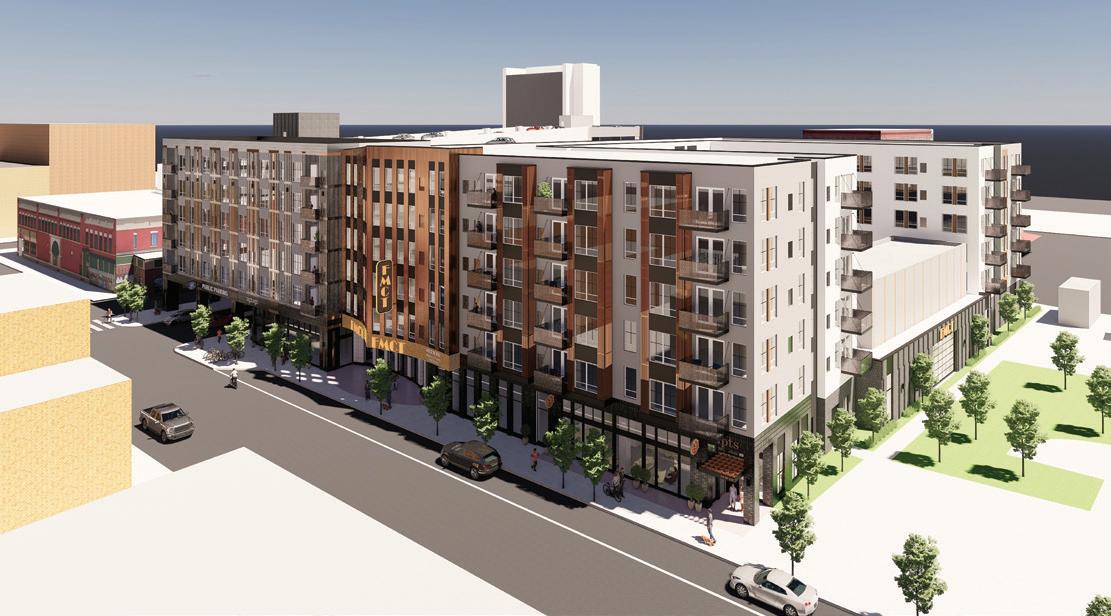
The Avery is Kilbourne Group’s newest mixed-use project. The urban infill project will replace the surface parking lot on NP Avenue between Old Broadway and North Dakota State University’s Renaissance Hall. The Avery will offer 168 units with well-appointed finishes and amenities, including bike storage, a fitness center, rooftop deck, and pet run, all with new views of downtown, Renaissance Hall, and Island Park in the background. The project also includes a 2,525-square-foot ground-floor commercial space for lease.
The project is a public-private partnership with the City of Fargo, as it also includes a 472-stall structured parking garage owned by the City. This is the fourth parking structure built in downtown Fargo since 2017, which brings over 2,000 public parking spaces to downtown Fargo and the central business district. It will also be home to the new FargoMoorhead Community Theatre. The new theater space, which will have more than 400 seats, will be a state-of-the-art venue equipped with cutting-edge theater technology, making it an immersive learning environment for technical students interested in various aspects of theater production. Additionally, the space will offer meeting rooms and common spaces accessible to the community, serving as incubators for creativity, education, and social gatherings. The parking garage is set to open in 2025 and the remainder of the project in 2026.
60 JUNE 2024
Submitted by JLG Architects
RIVERHOUSE

RiverHouse is under construction in downtown Fargo along the banks of the Red River of the North. Designed for those who want to be in the amenity-rich downtown energy and surrounded by nature, residents will enjoy direct access to the water, beautiful views, and kayak storage. The 115 living units of the RiverHouse will include expansive floor plan options with room for dining tables, high ceilings, heated parking, a fitness center, rooftop amenities, and spacious bedrooms. It is set to open in the fall of 2024.
KILBOURNE



kilbournegroup.com /kilbournegroup @kilbournegroup

 By Brady Drake | submitted by Jay Nelson
By Brady Drake | submitted by Jay Nelson
COMMERCIAL REAL ESTATE ADVICE
Q Can you tell us about your background and experience in commercial real estate
A: I spent 30 years in the hospitality industry prior to the recent 20 years as a full-time commercial realtor. I'm a member of the CCIM (Certified Commercial Investment Member) Institute, which only 10% of commercial realtors nationwide can claim. A CCIM has received advanced training and provides sample transactions to the institute based in Chicago, which are graded to ensure a strong knowledge base and the ability to implement the institute’s teaching. In the state of North Dakota, there are only 15 CCIM members, and not all of them are active in the brokerage business.
Q What current trends are you observing in the commercial real estate market
A: I'm seeing shorter lease terms and fewer square feet being used per employee. There’s still work left to be done regarding how hybrid work models impact space usage, and this change will take time for space users to understand, and then for the market to adjust to.
Q What are the key factors business owners should consider when looking for commercial property
A: Functionality, location, timing, and price.
JAY NELSON Archer Real Estate Services

Q What are some common challenges that your clients face, and how do you recommend they handle them
A: Clients are busy running their businesses, and when it’s time to find a new lease space or acquire a property, that gets added on to the daily workload. Responsiveness and momentum are important in a commercial real estate transaction, so tasks related to the lease or acquisition need to move up the daily priority list.
Q What are the advantages and disadvantages of leasing versus buying commercial real estate
A: For a buyer, the benefits are appreciation, depreciation, and a fixed base occupancy expense for the duration of a mortgage. For leasing, the benefits are nimbleness to change locations, shrink, or expand.
Q In what situations would you recommend leasing, and in what situations would you recommend buying
A: Lease if your business model is easily competed with, or if your staff size could increase or decrease rapidly. Buy if your strategy is to acquire and hold, and have your asset appreciate over time. In general, if a business's net profit percentage is greater than the annual appreciation potential of a property, then lease.
64 JUNE 2024

CONTINUE FARGOINC.COM 65
COMMERCIAL REAL ESTATE ADVICE
WITH JAY NELSON
Q Are there emerging areas or types of properties that you think will be particularly important in the near future
A: Medical offices, self-storage, and warehousing are all examples of properties that are in demand now and seem destined to be so in the future. I’m also interested in the ghost kitchen concept and am watching closely to see if it has long-term potential.
Q What predictions do you have for the future of the commercial real estate market
A: Property users, for both lease space and to acquire property, are important and a key source of a commercial realtor’s business. Often overlooked is that commercial real estate can be a good investment, both for a beginner and for a sophisticated buyer. It is the investor buyer who helps define market values, taking into consideration a tenant’s business model, creditworthiness, the location of the property, the size, and condition of the property, and the rent and return on investment. These sophisticated buyers generate transactions that may be used as comparable sales for user properties. Buyers should educate themselves on market conditions, societal trends, local growth patterns, cap rates, and business models that have some longevity to them. A good commercial realtor can be a valued team member.
Q What legal or regulatory issues should business owners be aware of
A: A significant factor is zoning. Understand the property’s underlying zoning and whether that allows your anticipated use of the property. For a tenant that utilizes space for large groups of people, understanding building codes, especially “assembly use,” is important.
Q How can a business assess whether a property aligns with its operational needs
A: If the business relies on inbound customer traffic, then being near customers is more important than ease of commute for the owner and employees. For some retail uses, simply being on the right side of the street is important. For instance, if you’re selling take-and-bake pizzas, being on the right-hand side of the street when evening traffic flow is dominant (right turn in, right turn out); for a coffee shop, being on the righthand side of the street when morning traffic flow is dominant (right turn in, right turn out). Every business is different and one way I help clients find the ideal location is to find a similar business that is dominating its market, then do a 1/3/5 mile demographic study of that highperforming location… then look for similar demographics in the market the client is interested in.


CONTINUE
66 JUNE 2024
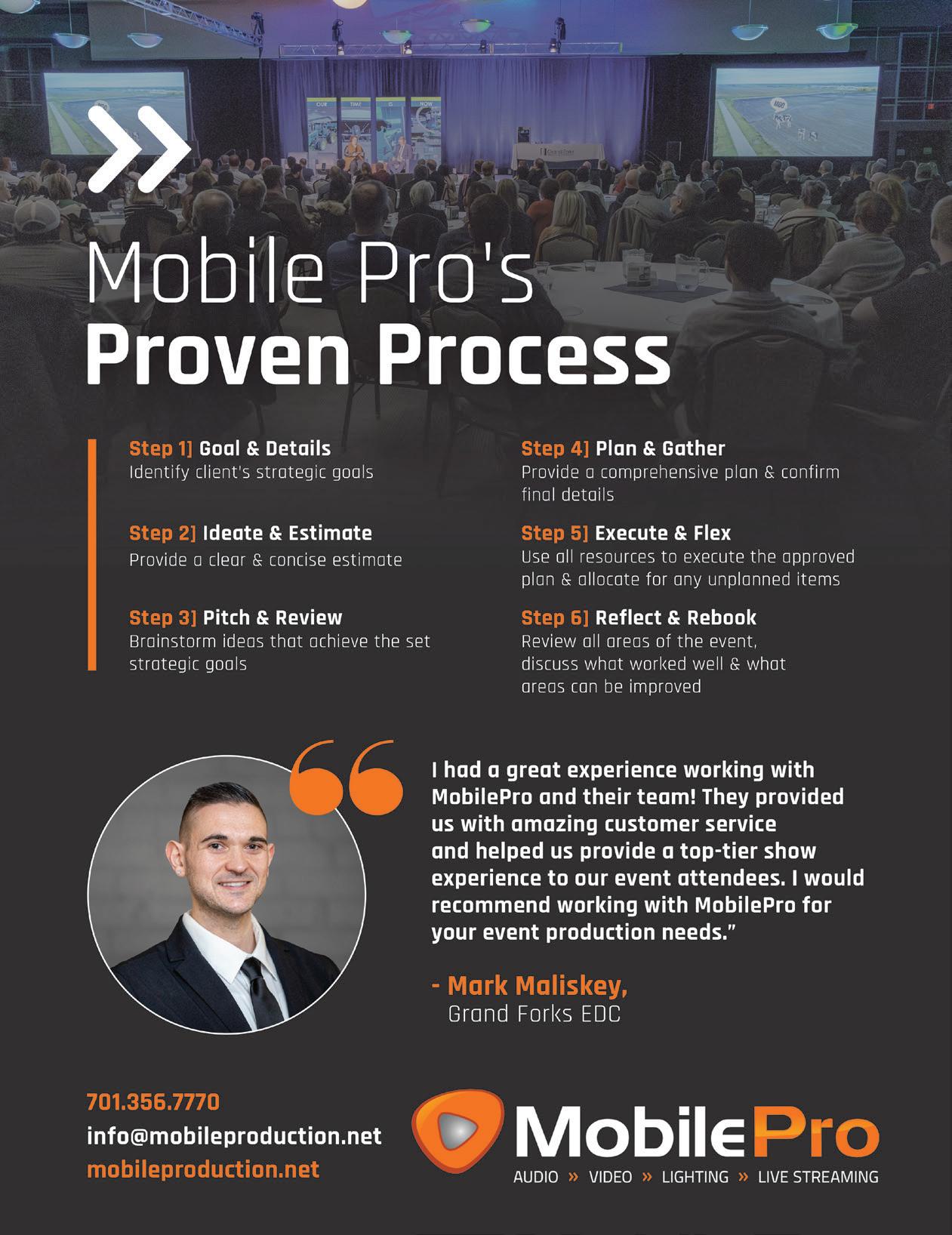
COMMERCIAL REAL ESTATE ADVICE
WITH JAY NELSON
Q What negotiation strategies do you recommend for firsttime commercial property buyers
A: For the property type, the client is interested in, we can use the client's budget and the geographic preference to dig and find similar recent transactions that help us understand market conditions and whether buyers or sellers have leverage on the other.
Another important thing is not to fall in love with brick and mortar—be willing to walk if the deal isn’t right. There’s always a new day and a new deal.
Be prepared. Line up a team that includes a commercial realtor, insurance agent, lender, attorney, and contractor. Be ready to move quickly and aggressively. Have your ducks in a row in advance.
Q How can business owners ensure they get the best terms in lease or purchase agreements
A: Business owners are skilled in what they do day to day. A commercial realtor is skilled in understanding what deals are getting done and what terms those deals include.
A business owner who negotiates a lease every five years or so is at a serious disadvantage compared to the landlord, as the landlord is likely a professional and does this type of work daily. Find a skilled commercial realtor to represent you (the tenant) to better understand the market conditions that may give you leverage in a negotiation.
Having an attorney review the lease and make certain that the tenant understands obligations is also mandatory.
Q What are some common cost pitfalls in commercial real estate transactions and how can they be avoided
A: For first-generation lease space, delivered from landlord to tenant in some condition less than finished, negotiating a tenant improvement allowance and understanding the costs to finish the space is essential. For example, if a landlord offers a $25 per square foot tenant improvement allowance, but the actual expense to finish the space is $50 per square foot, then there is a gap that needs to be closed, either by the landlord paying more, the gap amount being amortized over the lease term, the tenant paying more, or some combination of the three. Commercial leasing is the most complicated
JAY NELSON,
assignment for a commercial realtor and even more so for an unrepresented tenant.
Q Are there lesserknown expenses that business owners frequently overlook when budgeting for real estate
A: Budgeting for a lease space when the occupancy expense is comprised of a base rent and a CAM (Common Area Maintenance), know that the CAM can increase yearly based on true operating expenses. A CAM is generally estimated at the beginning of the year, collected monthly, and then reconciled at the end of the year. If the estimate at the beginning of the year was low (which allowed a property to be inappropriately marketed with an artificially low CAM rate) then the tenant is getting an invoice at the end of the year to make up the difference. Landlords can control some CAM costs, but not all; if it’s a snowy Winter, CAM may increase due to extra snow removal, and the opposite could also be true. At the beginning of the lease negotiation, certain aspects of the CAM can be negotiated.

Mobile: 701-730-0290 Office: 701-730-0290
CCIM jaynelsonarchercommercial.com 68 JUNE 2024





72 JUNE 2024
2024
EDxFargo is back this year, and it's set to claim the stage and the curious. The 2024 event is ready to transport attendees to a realm where the familiar meets the fantastical. This year's theme, "If," beckons the daring and the dreamers to venture into the obscure terrain of the unknown. Breaking away from the conventional, the event promises to blur the lines between reality and imagination.
Slated for July 25 as usual, TEDxFargo aims to deliver a world-class experience, highlighting the community, nation, and beyond through a local lens. A curated lineup of speakers will guide attendees through a journey of perpetual curiosity, challenging assumptions, questioning certainties, and exploring a myriad of "what if" scenarios.
We have a sneak peek of the event here, and we're excited. Let's meet some of the TEDxFargo 2024 speakers!


FARGOINC.COM 73




Amanda Schneider
ThinkLab, Founder & President
74 JUNE 2024


Catherine CurryWilliams
She Angels Foundation, Co-Founder

FARGOINC.COM 75

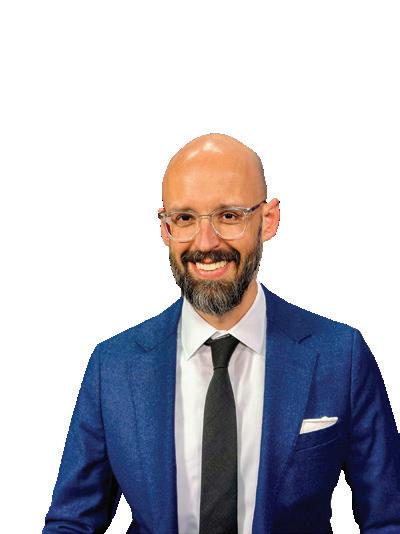 Eric Smith
Eric Smith



Betsy Fore
Natives Rising, Co-Founder & Board Member
76 JUNE 2024


Missy Heilman
BIO Girls, CEO

Mom to three daughters and wife to husband, Tom, Missy balances her time with family duties and a love for adventure. Whether it is traveling, mountain biking, running, competing in Ironman triathlons, or cheering her kids on in their activities, Missy tackles it all with enthusiasm. She is a graduate of the University of North Dakota where she competed in track and field and earned degrees in exercise science and nutrition. As a recipient of an NCAA postgraduate scholarship, Missy went on to earn an MBA from NDSU. Missy serves on the UND Letterwinners Association board, is an uber fan of track and field, and enjoys snuggles with her cat, Harry. Often described as 'fearless,' Missy's favorite piece of advice for the young and old alike is to not fear failure.
/missyheilman @biogirlsinc @biogirlsinc

Evelyn Chambers
High School Student
FARGOINC.COM 77





Arianna Genis Maddy Matson
P3 Lat at Johns Hopkins University, Organizer-In-Residence & Research Scholar
Swarthmore College, Undergraduate Student, Full-Time
78 JUNE 2024





Smoot
80 JUNE 2024
Nick
Aesop Industries, CEO


SixDegrees.Org, Executive Director

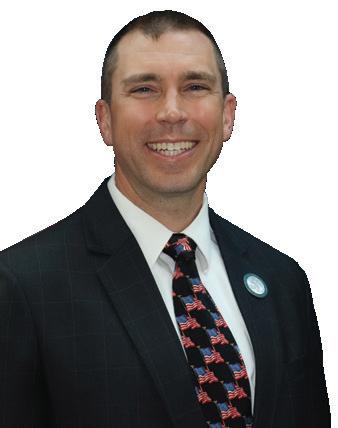
Stacy Huston Derek Tournear
Space Development Agency, Director
*a component of the U.S. Space Force, under the United States Department of Defense
FARGOINC.COM 81




82 JUNE 2024
Gabe Brown Understanding Ag, LLC, Co-Founder & Managing Partner

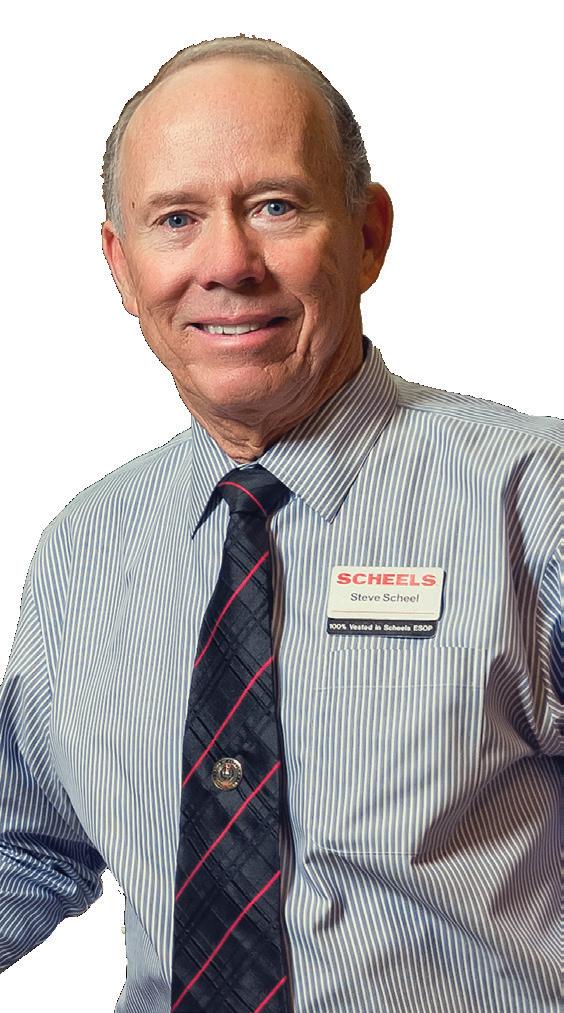
Steve D. Scheel
Chairman of the board, SCHEELS

FARGOINC.COM 83
J Alan Photography
Meet the Creative

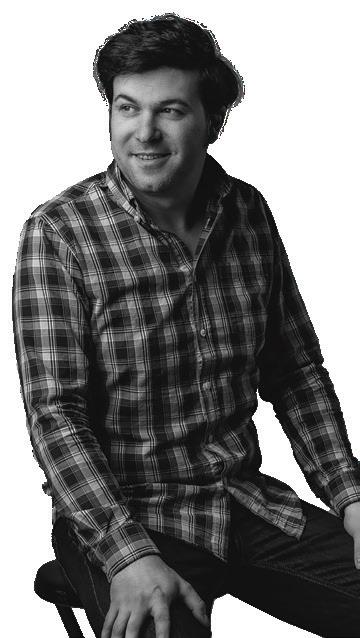
Jeff Knight
eet Jeff Knight, the graphic designer behind this year's TEDxFargo "If," as well as past events' designs. Jeff is the founder of Cereal, a studio dedicated to brand enhancement. Year after year, Jeff masterfully designs each TEDxFargo logo, capturing the spirit of every abstract and unique theme. Peek into Jeff’s world as he worked on this year's design, offering you an exclusive look at the creativity and process behind his work!
"The design phase this year began with a meeting early on where the planning team at Emerging Prairie presented the theme of 'if' and we discussed what that might mean. It was a very open-ended theme with plenty of room for questions about where the narrative could go. We had discussions involving multiple different directions. Ultimately, through a few brainstorming meetings, the EP team and I kept coming back to discussions around the ethereal and imaginative nature revolving around events that held mystery and possibility. While thinking about the event, I had a random vision of a large, empty stage with an antique cart being wheeled out. On the cart was an old-time phonograph that would start playing some oldtimey, eerie music. A solitary spotlight would shine down, surrounded by smoke, as the record began to play."

"This would lead to the initial direction of the ideation phase. To get another perspective, I rounded up a team of students who are part of the SoDAAHAUS graphic design fellowship program I head up at NDSU. I tasked them with finding some visuals that they associated with my vision of the mysterious phonograph on stage. Their visual findings were very different than mine. My vision focused on things that were based around an antiquated, Victorian-era, design. Think sepia-toned photos you’d find in an antique store. In fact, I even used an AI generator to achieve a better idea of what I was envisioning. I tried a variety of prompts, which yielded results that were close, but not quite what I was looking for."

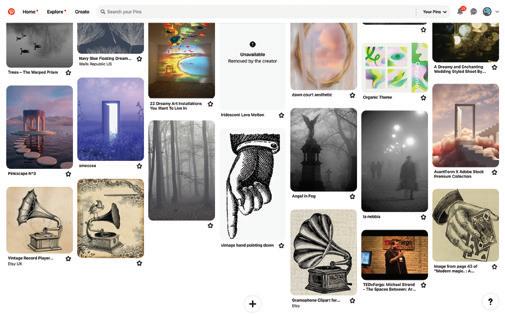 A peek at the Pinterest pins that started the design process!
A peek at the Pinterest pins that started the design process!
84 JUNE 2024
"The student’s vision included more luminous and neon colors, distorted shapes, and people. Their examples really began to reality in ways that I felt were really vibrant and engaging."
"I liked their vision much better. So, I ran with that concept in coming up with a few options presented to the team at EP. After a follow-up discussion, we used a combination of ideas to come up with a neon, art nouveau, fever dream. It is not meant to be scary, just a bolder, more psychedelic, approach to one’s journey and allowing the viewer to dive into the various sections of visual direction."
"The illustrative chaos led to the creation of various sections prime for different visual activities that I felt could better be explored with movement. I turned to a co-worker of mine, Artist and NDSU Art Professor Andrew Stark, to help me animate different sections of the piece to really bring it to life and allow the chaos to move."




"The final part contribution was to make up a small collection of templated social media posts that they could use to maintain graphic consistency when they begin to announce speakers via social channels."
"With that, I gave the designs over to the EP team and let them take things from there to decide how they wanted to include the graphic elements in their planning of the event. They always do an awesome job of interpreting what I present them and take it fully into the promotion and visual complexity attendees will see at the day of the event. It will be fun to see what they come up with!"
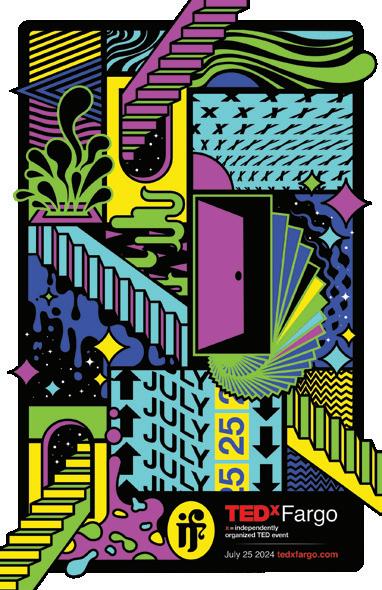 These are some of the AI-generated images that Jeff created while narrowing down the exact vision of the graphics!
The final designs for the 2024 TEDxFargo event, "If."
These are some of the AI-generated images that Jeff created while narrowing down the exact vision of the graphics!
The final designs for the 2024 TEDxFargo event, "If."
FARGOINC.COM 85


Meet the Creative Sydney Ulrich
eff Knight isn't the only local artist making an impact at the 2024 TEDxFargo event. Meet Creative Entrepreneur Sydney Ulrich, the young artist responsible for the TEDxFargo T-shirt and alternate poster design. Sydney Ulrich has been making art for as long as she can remember, and now, she's making art a business with her company @sydscoolart.
"My mom sewed so we always made our own Halloween costumes," Ulrich said. "I've just always been encouraged to be creative."
In high school, she was the editor of her school yearbook. She started taking pictures of her friends and posting them on Instagram, and almost immediately, friends were asking her if she could take their pictures. "Pretty quickly that snowballed into me taking pictures at concerts," Ulrich said.
Ulrich graduated from NDSU with a major in strategic communications and a minor in graphic design. "I was doing graphic design on the side, making birthday cards and, honestly a lot of memes for my friends."
"I was in this communications class that had a lot of drawing in it and I just loved that. I didn't really care about the technical side, I just wanted to make the ads look pretty. I knew I could doodle, but I whipped out this hyper-realistic charcoal drawing of my grandpa. I didn't know I could do that."
From there, Ulrich's professors strongly encouraged her to continue with her art. She almost didn't listen but had a negative experience at an internship that steered her back into the creative realm.
Ulrich's last two and a half years at NDSU were spent exclusively at the art building, which allowed her to explore all sorts of different mediums.

86 JUNE 2024

This graphic is full of easter eggs, see if you can find them!
"That experience opened my brain to all of the things I can do," Ulrich said.
Before graduating, Ulrich created a rotoscope animation that won a regional gold American Advertising Award and a national silver American Advertising Award.
"That got me a lot of attention and I was able to meet a lot of people around town," Ulrich said. "It opened a lot of doors for me."
What if?
"Emerging Prairie reached out to me and told me they had been watching me for a while, and they wanted me to work on the T-shirt and alternate poster," Ulrich said.
To go along with the theme of "If," for this year's TEDxFargo event, Ulrich and the Emerging Prairie team coordinated to create a "magical fever dream graphic."
"I usually go to Pinterest for inspiration—to get some ideas flowing. I do that because I can't picture pieces in my head. So, I like to see things in front of me. I like to use inspiration and find color palettes and stuff that I can draw and implement into my design. Then I create a couple of sketches, send them off to get feedback, and then we work from there."
Ulrich tries to create a sense of FOMO (fear of missing out) in her work.

"I like both my graphic design and photography to not be a regular style. I don't like them to be something you'd typically see. With my photography, I like to capture the energy of a moment and create curiosity because curiosity creates a conversation. With my graphic design, my stuff is very funky and out of the ordinary. It has trippy, groovy-type vibes. It's not super hyperrealistic."
The Easter eggs in her TEDxFargo design include a red rug symbolizing the red dot people stand on to give their TEDxFargo speeches, name badges from past TEDx events, a TEDxFargo swag bag, a donut to represent the free donuts given to attendees, and a can of Poppi, which is a sponsor of this year's event.
@SYDSCOOLART
You can come to Ulrich for promo posters, social media reel creation, logo creation, and photos—"really anything creative," she said.
"If you have an idea but don't know how to make it come to life, I got you," Ulrich said. "I'll come to talk with you and I will help make your ideas come to life."
"I'm a super happy, positive person who just wants to help get people's visions come to life."
FARGOINC.COM 87


Calendars! Mark Your



88 JUNE 2024


 By Brady Drake | Josiah
By Brady Drake | Josiah
has been almost a year and a half since Kevin O'Leary's O'Leary Ventures was chosen by the North Dakota Development Fund to manage the $45 million Wonder Fund North Dakota program.
Since then, the fund has made eight investments—some of which are not public yet. We spoke with O'Leary Ventures CEO Paul Palandjian to learn about the companies they have invested in recently that he can talk about.
90 JUNE 2024
Kopp
Thread is an energy and utilities asset-maintenance technology startup based out of Grand Forks that has received two seperate investments of $2.5 million, totaling $5 million, from Wonder Fund North Dakota. We asked Palandjian why they doubled down.
Palandjian: When you make venture investments, you are always kind of underwriting the opportunity from the perspective of what the potential return could provide to the fund. This is a business we have a strong conviction could be a fund returner. In other words, that one investment could end up potentially returning the whole amount of the $45 million fund we are managing. That $5 million has the potential to be a 10x return.
That company needed a little bit more capital because of the way they have progressed. And, in our original investment, we had a kind of tacit agreement with them that we would make the initial investment, get to know them better, start to roll up our sleeves, and get active with the company, and we wanted the ability and kind of a first option to put more capital into the business.
That's also one way we manage risk—by not writing the whole check
day one. Instead, we write a check, see how they operate, and develop that relationship. It's kind of a land and expand strategy—that's not uncommon with venture funds. This method allows you to double down with the winners. Thread is a company we've identified as a huge potential winner.
Since that initial investment, they've gone out and locked down some contracts that suggest their revenues are going to ramp up very nicely.
They've shown huge promise. They're doing a couple of million in recurring revenue and it looks like they're going to spike to four or five times that.
We have proof of concept and commercial traction. We were also able to take look to the sovereign wealth funds in the Middle East, which have economies built entirely around oil and gas. One of the applications of Thread is the autonomous inspection
of critical infrastructure and assets for large utilities and potentially for oil and gas companies—inspecting pipelines and things like that. So, from the time we made the investment to the time we made the follow-up investment, we were able to use our network to validate interest and demand for the product further. We're actively engaged in those conversations with some big international investors who are potential customers of the company as well. So we hope to leverage that network to support their growth in the future.


Tavolo is a company founded by Fargo native Taranvir Johal. The company is based in Minneapolis and is a a AI-driven marketing solution for restaurants. The Wonder Fund recently invested $250,000 in Tavolo and we asked Palandjian to tell us about the company and the opportunity the fund saw.
Palandjian: Restaurants, many of which are small businesses, family businesses, mom and pop in their nature, are just doing the best they can to serve good food and make sure that logistics and costs are where they need to be. So, they can be kind of weak when it comes to marketing. But, the whole world has changed now. You have to build not only a good business, deliver great food to the customer, and generate this kind of repeat customer base, but you also have to use social media and
various forms of distributed digital distribution to build your community.
Tavolo is using AI-generated marketing campaigns and plugging in with these restaurants to give them much more robust insights into their data. They help the restaurant figure out who the customer is and what their preferences are.
In business, there's kind of an 80/20 rule where 20% of your customers will create 80% of your revenue. So,
it's not always the case that you want to acquire new customers, although that's very much a part of every marketing campaign. But you also want to have the ability to get your current customers to come in and buy more.
This is a great example of how technology is changing. AI affords you the ability to do a great many things without hiring a lot of people. Right now, the current restaurant regime is all using point-of-sales
thread.one /threaddata
Learn more about Thread
FARGOINC.COM 91
systems. There are various ones out there and those companies that are providing that point of sales system tend to own and control most of the data and the restaurants themselves are not even really astute in knowing their customers at that granular level. Tavolo is a bridge for that. They're able to tell you what your hero products are versus the menu items that are selling less. They give these robust insights. They generate marketing campaigns that can improve sales of certain items. They help run specials if certain menu items are not being sold.
The use case that got us very excited was a small cafe in Minnesota that they were serving. The cafe was originally doing $20,000 a month in gross revenues, and once they started using Tavolo, they increased their sales to $80,000.
Matt and I were both mentors for the
Techstars Farm to Fork program—we met Tavolo through that program and we were proactively looking for good companies to invest in. Out of the 12 to 15 companies we encountered, Tovalo was the one who kind of checked boxes for us as far as having a great founders group that we thought didn't know the meaning of failure—they're just going to persevere and execute. They're just three young, energetic, smart, visionary guys with different skill sets who work well together as a team, and they have already gotten some traction for their product. We think the product is excellent.
Outside of our North Dakota mandate, we recently bought a franchise business in the food space called Brookly Dumpling Shop. So, we were able to connect them with the CEO of that company and they're rolling out Tavolo in that company. So, there's kind of a virtuous cycle where we can get involved with the business, and
then use our network, whether it's a company we own and control or another company.
After we invest, we're able to use Kevin O'Leary's platform to tell the story of a company when the time is right. It's got to be carefully curated and coordinated with the company to meet its marketing needs. Sometimes companies like to stay stealth while they get to scale and not necessarily prematurely invite competition to what they're doing. We respect that. But once the company says, 'Okay, how do we work together to really get the word out and get more customers?' That's when we leverage Kevin O'Leary's network and social media presence to help that company.
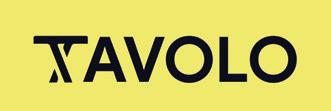
Drut, a company that recently received a $1 million investment from the Wonder Fund, is pioneering a new approach to AI data centers by using a photonic mesh application, which aims to decentralize and improve the efficiency of these centers. We asked Palandjian to explain further.
Palandjian: What's happening in the world of AI today is that you have new chips that are being developed with enormous processing capabilities and there is an unmet demand for AI compute data centers as well which require an enormous amount of energy to drive them. Cooling them is also an issue. The GPUs themselves suck up a lot of energy so you have a number of companies that are trying to innovate to create a more efficient way for those data centers and those GPUs to operate.
Drut is using a photonic mesh application... that will decentralize data centers, and allow them to operate more efficiently and also

be upgraded over time in a more efficient manner. Right now, every four years, you have to rip out the racks and the GPUs and there are new computers and different sizes which have different requirements and all of that costs an enormous amount of money. It's almost a complete rebuild of what's inside a data center.
Just for some context, a modern day AI data center costs about $10 million per megawatt, just for the building. And that's before you even put the racks and the computers in. The reason for that is because you need an enormous amount of power brought to the site. You need redundant fiber optics coming in
all four corners of the building. And you need backup power. It's almost like building four in one. It's nothing like the past generation of data centers. One of the reasons for that is because the large mega scalers have a requirement that you have to be up and operational 99.999% of the time, which equates to only 26 seconds a month that you can be down.
Otherwise, their large language learning models get thrown off. So, there's a huge cost if a data center fails and can't support the power requirements and the operational needs of that end user. So, you have to kind of account for all of that when
92 JUNE 2024
you build it. And then on top of that, the minimum requirement today by those mega scalars is 100 megawatts. So, what you're trying to deliver to them is an enormous undertaking. It's $2 billion just for the building. Then, they're spending $25 million plus per megawatt, just for the racks and the GPUs. And then roughly every four years, those all become obsolete and you have to rip them out and turn them over.
So, what Drut is attempting to do is create a photonic mesh, decentralized method of stitching together a data center network. By doing this, everything requires less cooling and there are lower switching costs. This could allow you to pop out the old chips and put in the new chips—it could be revolutionary.
Now, you can have the best product in the world, but you need the industry
to adopt it. This is a company that was founded out of MIT and is very well venture-backed by some of the smartest VC investors. We have very high hopes that the industry will adopt it, but it's the early days.

The Wonder Fund recently invested in HerdDogg, a company using bluetooth-enabled smart tags to continuously monitor animal movement and temperature to give realtime health alerts. With a number of cattle monitoring solutions on the market, we asked Palandjian why they chose HerdDogg.
Palandjian: It's early days in the industry. There are only a handful of companies doing tagging and realtime data analytics. It's about herd health, ultimately. Their software gives you pre-emptive capabilities to be able to detect if cattle are in distress so you can separate them from the herd. If they're in distress, that might be indicative of an illness that you don't want to spread to the herd. So, this is a space that we believe will be huge and ubiquitous.
Palandjian: We're coming up on a year and a half since our program began with the state and we have been blown away by the quality of the talent within the state and the efficiency with which the state operates to make resources available to support small business and startup activity within the state.
We have professional management and investment discipline that we have a conviction will enhance outcomes for the state over the long term. Our only constraint at this point is capital. We want to do a lot more. There's more opportunity than we
It's an industry that's slow to adopt new technology.
We think the product and science is good. The CEO who came into the business has a great track record of having built and sold businesses. The big acquirer of these businesses is the animal science division of big pharma companies and he has a demonstrated track record of doing that. He is also a cattle rancher. His family is very prominent in the
have the funds to be able to deploy right now. So, we're already thinking about what's next.
What you're going to see from us in the coming years is that we're going to actually grow the nexus of everything that O'Leary ventures does in North Dakota. We opened an office in The Hive in Grand Forks, and we're going to open an office here in Fargo. We're going to start to scale management and a lot of our back-office activities—accounting, compliance, and legal—in the state as well. We're going to build something that we think we can all be very proud
National Cattle Association. They have a substantial herd of cattle.
Because of his connections within that industry, they have a very low cost to test and develop the product. We like the investor group and we like the valuation that we were able to invest at.

of. We're seeing a lot of opportunity throughout the heartland. Our business vision is to focus on North Dakota and beyond, where these state economies have similar core attributes and where we can support them... We're just getting started. We're super excited about what we're seeing. We just want to be thoughtful about how we grow and expand.

Check future issues of Fargo INC! for more updates!
FARGOINC.COM 93
By Leah Peterson / Brady Drake | provided by Prairie Design Studio

Prairie Design Studio is your premier destination for commercial and residential architecture in Fargo. Located at 5302 51st Ave S, Suite D, and accessible through prairiedesign.com, they specialize in commercial spaces, with a tremendous resume of fit-up designs. From the new shaved ice shop of Vampire Penguin (Fargo) to the up-and-coming Soul Boutique (Dilworth Rail District), and hot and unbothered Club Pilates (Fargo), their recent fit-up ventures speak volumes about their dedication to bringing clients' unique and personal businesses to life.
But what exactly is fitup design? It's the art of preparing an interior space for a new tenant, whether it's in a strip mall, a shared office complex, or a standalone building. Join us, as Prairie Design Studio helps us explore tips for this crucial step in the design process.

Create the Perfect Office Fitup

 Leah Petersen, Architect
Leah Petersen, Architect
94 JUNE 2024
Chelsey Johnson, Architectural Project Manager
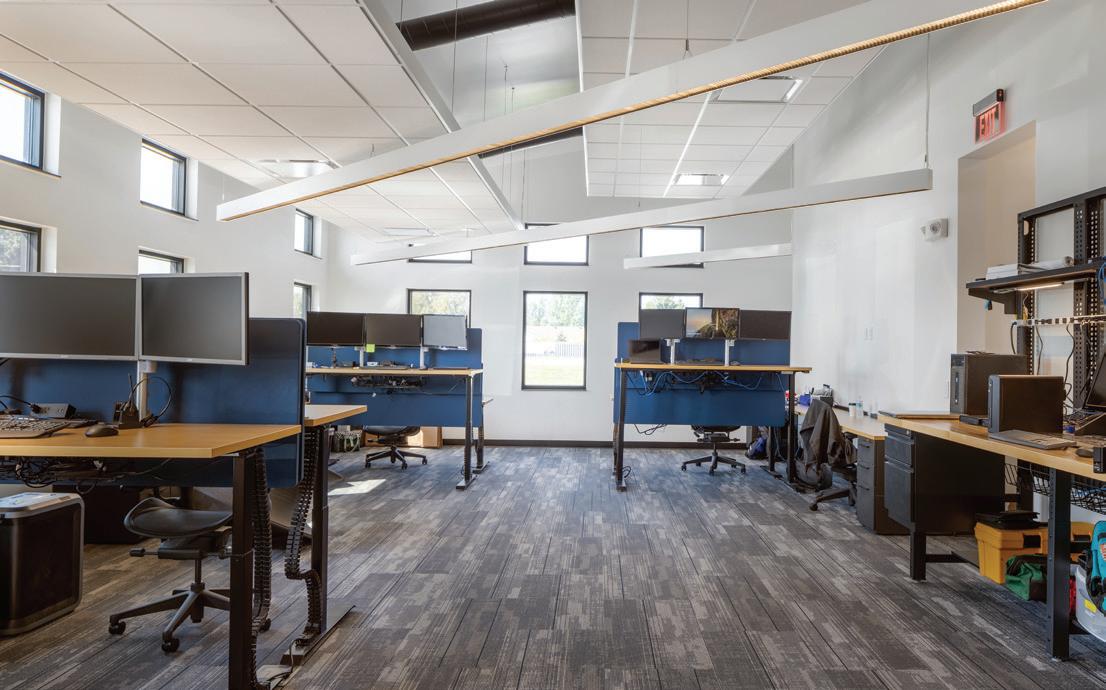
Pull in Natural Light

"Oftentimes, windows are limited, so maximizing the amount of light is crucial."
Ways to do this:
Put cubicles, open rooms, or more public areas on outside walls so natural light isn’t blocked by offices.
Orient private offices around open spaces with glass to pull light through.
Put transom (high) windows or regular glass in the walls of centralized rooms to pull in the natural or shared light
Central Location is Key
"Keep accessory spaces, such as print rooms or storage centrally located to provide easy access, sound control/buffer between offices, and to not take up exterior walls where windows are located."

This conference room at the Dwyer Law Office was built with transom (high) windows to allow extra light into the space.
CONTINUED > FARGOINC.COM 95
Think About Acoustical Control
"Provide soft materials and finishes wherever possible, such as acoustical ceilings, acoustical lighting fixtures, carpets, and soft furniture or rugs."
Insulation
"Provide insulation in walls and, if the budget allows, install resilient channels behind sheetrock and lay additional sound insulation above dropped ceilings."


Near the Main Enterance
"Keep public spaces, such as conference rooms and bathrooms, towards the main entrance for security purposes, to eliminate disruption to employees and easy access for clients."
Decorative Lighting
"Add decorative lighting, especially at main entrances. This is an easy way to add interest and draw guests to a focal point (such as a reception desk) when first entering a space."

Create the Perfect Office Fitup
Lowry Engineering kepts acoustics top of mind during their build.
96 JUNE 2024
Example of decorative lighting can be found at The Collective Salon and Spa.


Brand Colors
"Incorporate brand colors. Clients will feel more immersive in your branding when in your space. Paint colors, light fixtures, and furniture are easy ways to do this if you don’t want something so permanent."
Stay Flexible
"Design flexible spaces, such as breakout rooms to chat with coworkers, and have impromptu meetings, lunch breaks, or phone calls."
Sprinklers Are Key
"If you are in need of a larger space, it is ideal to find a building that is has sprinklers. Not only is it safer, but a building with sprinklers has more leniency with building codes, such as the use of spaces, fire ratings, and building layouts."

CONTINUED >
Plains Title added its yellow to the wall in this room.
Prairie Design Studio Fitups
The
This fit-up consists of a hair and nail salon, along with leasable rooms for individual small businesses, such as massage therapy and aesthetics. It is located in the Rail District of Dilworth, where a lot of new small businesses have opened up!





The office fit-up for Dwyer Law was finished back in 2019. It included multiple private offices, meeting spaces, and a reception area. They recently had a few private offices open up so Prairie Design Studio decided it was time to leave their home office in Horace and venture into a more professional environment, making their recent client fit up a space of their own!




Create the Perfect Office Fitup
Dwyer Law
98 JUNE 2024
Collective Salon and Spa

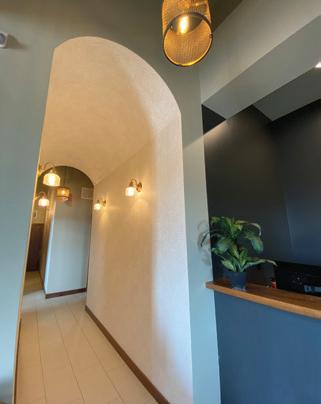


6 Design Trends for Your Office Space
Provide movable walls for easier future space planning such as DIRTT walls.
Incorporate plants or living walls to create a soothing environment and better air quality.

Create entertainment spaces that work for client meetings, but also hosting small events.
This fit-up was originally designed for a title company (Plains Title recently merged with The Title Team). The design included multiple private offices, a cozy waiting area, and open work spaces for cubicle-style desks or future private offices.

When selecting furniture, look for timeless pieces, such as solid colors, woodgrains, and options with multiple configurations. Stay away from busy patterns and trends of the moment.
Incorporate local artistry, such as a painted mural, custom wallpaper, sculptures, or specialty fixtures.
Archways are a fun way to break up space while bringing in a designer touch. Instead of just a single opening, go the extra mile and do a barrel ceiling!
prairiedesign.com /prairiedesignstudio @prairiedesignstudio
FARGOINC.COM 99
Plains Tile

MEET VENTURECHAMPION PARTNERS
NICK EDWARDS MARQUES
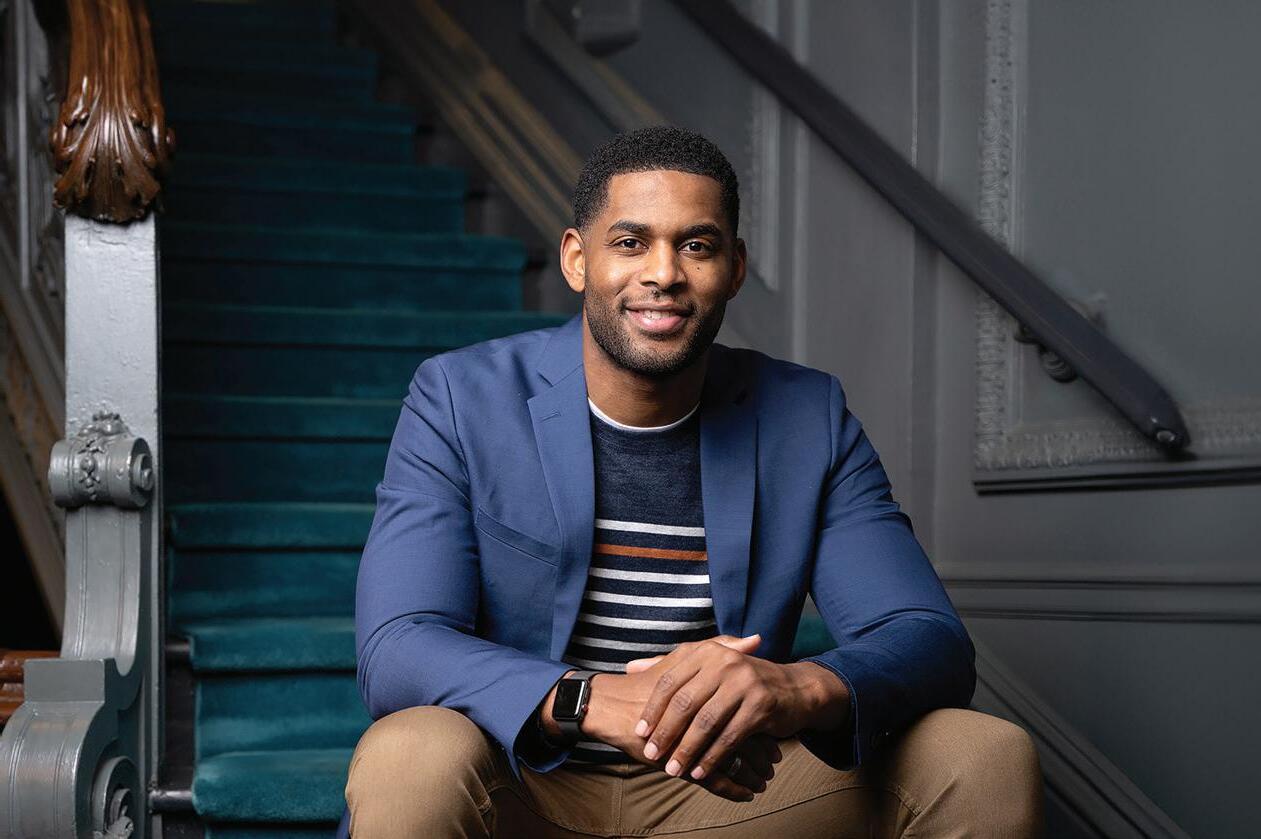
100 JUNE 2024
COLSTON
By Brady Drake | Courtesy of Champion Venture Partners

Nick Edwards has been making some major moves recently. In January of 2023, the former professional MMA fighter and current physiologist for the Colorado Avalanche and Denver Nuggets founded BixonX, an evergreen nonprofit startup studio and venture capital ecosystem with the goal of supporting regional founders from idea to launch. Being a physiologist at the highest level and running a venture capital firm would be enough for most people, but NDSU graduate Nick Edwards is not one to sit still.
Now, he is teaming up with New Orleans Saints legend Marques Colston in his latest endeavor Champion Venture Partners, an investment management firm focused on building its portfolio around all things sports.


ABOUT NICK EDWARDS
Former NDSU athlete Nick Edwards is a nationally renowned physiologist and has built multiple medical programs for a wide range of populations that are currently running across the US. In his career, the former professional MMA fighter has also worked with organizations from NHL to NFL, Men’s and Women’s Division I NCAA Teams, podium Olympians, and World Champions, and he still currently serves as team physiologist for four professional teams.

ABOUT MARQUES COLSTON
As a member of the New Orleans Saints, Marques Colston set franchise records for receptions, receiving yards, and receiving touchdowns. He also reached the top of the mountain, winning a Super Bowl in 2009, and is a member of the New Orleans Saints Hall of Fame.
Even before finishing his playing days, Colston began dipping his toes into the business world. In 2012 he became the majority Owner of the Harrisburg Stampede, a team that at the time
Beyond athletics, Nick has worked in both the private sector and clinical settings, launching startups and fostering early-stage ventures. While his sweet spot is in health tech, Nick has been part of multiple startups, SPVs, has served as a general partner and limited partner, and worked in companies from launch, through fundraising, and on to exit. His philosophy lies in unlocking and harnessing each person’s unique motivation, and in turn, helping them find solutions and open doors for their successful ventures.

played in a league called American Indoor Football (AIF). After the 2014 season, Colston left that endeavor and purchased a stake in the Philadelphia Soul of the Arena Football League (AFL) which he maintained until 2019. He has also had minority ownership in the Albany Empire of the AFL and the Atlantic City Blackjacks of the AFL. In his post-playing days, he has also earned his MBA, worked as a professor, worked as an executive coach, and worked as a financial advisor.
102 JUNE 2024



Q&A WITH NICK EDWARDS & MARQUES COLSTON
Q: IS CVP YOUR MAIN FOCUS RIGHT NOW?
Nick: I hired really great people who are kind of handling all of the dayto-day stuff with BisonX.
With my background of being an athlete and working in athletics with the Avalanche and the Nuggets here in Denver, it was kind of a natural fit to segue into sports. And so everything that I've done with BisonX has really revolved around three asset classes—real estate, medicine, and sports.
More and more of my time is going into CVP and eventually, I'm probably not going to be doing anything else. So, BisonX is running really smoothly because I hired the right people.
Q: WHAT IS THE RELATIONSHIP BETWEEN CHAMPION VENTURE PARTNERS AND BISONX?
Nick: CVP came out of BisonX as one of its portfolio companies. We basically incubated the firm and then kind of helped get it going. We provided a lot of the initial structure and then launched it.
Q: HOW DID THE PARTNERSHIP BETWEEN THE TWO OF YOU COME TO BE?
Marques: Nick and I have been

working together off and on for about five years now. I was working in a sports data and analytics company I founded and at the same time, Nick was working in a complementary company. We kind of came together around the idea of collaborating within those two businesses. From there we just kind of continued to connect and continued to push our partnership down the line. He and I started to connect offline a little bit and kind of realized that we had this shared vision. That realization led us down this path with CVP and what we're building up today.
Q:
WHAT SPECIFICALLY IS THAT VISION?
Marques: It's really one around access. We want to disrupt the typical pathway to wealth. With us both being former athletes, we see sports as universal connectors.
So, we have the ability to leverage our backgrounds, passions, and professional experiences through the world of sports and all the pieces that connect it. We saw this as a perfect platform to be able to offer access to folks to try and build wealth using sports. Because when you think about it, whether you're an athlete at the youth level, high school level, collegiate level, or even professional level, you kind of have that throughline. That spirit and that mentality that it takes to play a sport connects us all. Sports is that one thing that everyone can come around the table and agree on.
Nick: We want to put athletes in the driver's seat. There's kind of a misinterpretation of athletes after sport. Athletes lack opportunities for meaningful investment in sports and you wouldn't think that's the case, but they've been left out of the room. After sports, athletes usually turn into mascots—that's not meaningful. And what's funny is the same thing that athletes are experiencing is the same thing that the retail investors are experiencing—there's not meaningful access into sport. There's access for things like the S&P 500, but people have a passion for sport.
For Marques and I, we both have been on this quest of education and bettering ourselves. If you're an athlete, you know that it's not going to last forever. So, one thing that's really important as an athlete is to say, 'This is what I did in the past, this is where I am, this is what I'm doing today, and this is where I'm going.' We've both really worked to make that evolution and transition in our lives.
Q: WHY DO YOU THINK THERE IS THAT LACK OF ACCESS?
Marques: There is a general lack of access. There is a huge inequity, and there's a huge wealth gap. I think what we see is with our networks and with our experience through sports, and what we know about not just the surface level sport but also the things that underpin being an athlete and being involved in sports, we see an area where we can really
FARGOINC.COM 105

Q&A WITH NICK EDWARDS & MARQUES COLSTON

impact the wealth gap.
Nick: I think that today, the average person basically has access to a few points of investments. I think everybody knows somebody who has a startup you can invest in— which can be extremely high risk. That's an option or you can invest in the S&P, which is steady. However, I don't know too many people who say things like, 'I'm an investor in the Timberwolves.'
That just doesn't happen—those opportunities are reserved for the quote unquote, elite or the institutional investor. We want to rewrite the script.
Q: SO WHAT TYPES OF THINGS IN SPORTS WILL CVP BE INVESTING IN?
Nick: We're investing in sports as an asset class. That can be anything from direct consumer goods to teams, to sports tech, to sports— anything across the board.
Q: HOW FAR ALONG ARE YOU WITH EVERYTHING?
Nick: So we are continuing to raise capital to get up to $100 million. So, people can still invest in us. We also aren't going to just stop at $100 million. We are already looking to enter an interval fund. We want this to be the largest retail investor asset for sports in the world. We want to
grow this thing.
Q: HAVE YOU GUYS MADE ANY INVESTMENTS YET?
Nick: No, but we have $30 million in warehouse deals were deploying.
We officially just launched in January and our coming out party was with the Super Bowl this year. It's wild how much attention we've gotten because there's nobody doing this. There's nobody doing it for the retail investor and nobody doing it for the athlete.
We're investing in growth-stage sports companies. We're not doing the high-risk startups. We're not going after early-stage companies. We're going after companies who, let's say, are already profitable in hockey and they think their product should work in football, but they just don't know how to get it there. That's where we come in and provide influence and strategic capital to help them get there.
HOW DO YOU GUYS GO ABOUT FINDING THOSE DIFFERENT POTENTIAL INVESTMENT OPTIONS?
Marques: There aren't a ton of firms that are sitting in the sweet spot that we sit in. A lot of these deals have been from relationships we have devloped or they've been inbound. Folks are seeing what we're doing.
And, we're filling a need for a very specific stage of a company. So we've been getting a lot of inbound interest.
Q: WHAT ARE SOME OF THE BIGGEST THINGS YOU GUYS LOOK FOR WHEN YOU'RE TRYING TO MAKE DECISIONS ON WHO TO PARTNER WITH?
Nick: We don't want to just mindlessly put money into a company. We're not just a passive investor. We truly have positioned ourselves to be a value-added type of firm. So what that means is when we go in, we want our investment dollars to make it one plus one equals three. We have a management company that sits sidecar to our entire fund. So, we can deploy things such as PR, executive leadership, operational excellence, and we can really help them scale into that new vertical.
HOW DOES NORTH DAKOTA FIT INTO ALL OF THIS?
Nick: We're going to be bringing capital availability and expanding sports ventures in the Upper Midwest.
Without professional athletics in parts of this region, it's going to be very important to draw sports ventures into the Upper Midwest to be able to compete for NIL dollars.
FARGOINC.COM 107

Q&A WITH NICK EDWARDS & MARQUES COLSTON
We're going to do it.
Q: HAVE YOU SOLIDIFIED ANY PARTNERSHIPS WITH SCHOOLS?
Nick: Nothing is solidified. I will tell you we're on meeting number three with the University of Colorado Denver. I'm on meeting number two with NDSU Athletics. We will have a partnership at some point, it's just a matter of with who and when.
The only partnership I can talk about for sure is the one we have with Pathway Ventures. They are the NDSU Student Fund and they're going after very early stage companies because their check size is under $25,000. So, they can't play with the big boys and growth stage companies who have a much higher minimum check size. So, we're giving them access to come alongside us and invest with us in very stable, high return companies.
Q: BEING SO BUSY DURING YOUR TIME AS PROFESSIONAL ATHLETES, HOW DID YOU MANAGE YOUR TIME TO PREPARE YOURSELF FOR YOUR EVENTUAL CAREER TRANSITION?
Marques: The thing that's helped me the most was just being able to dive in and learn, learn on the
fly. Diving in, in whatever capacity you have, is always going to be the best learning experience. When you do that, you're going to figure out the things that work for you. You're going to figure out the things that you need to work at.
A lot of people focus on the end result of athletics and the gameplay. To me, it's really about the process of getting to game day because that's the process that you recycle over and over again. You do it whether it's week to week trying to figure out how to win a matchup or whether it's year to year trying to figure out how to get to that next level. It's about having that mentality towards the process of development and being vulnerable enough and being okay with not being good at something. That was the thing that really allowed me to keep going even when things got tough.
Q: WERE THERE ANY SPECIFIC RESOURCES THAT HELPED YOU? ANY BOOKS?
Marques: There are a few books. There's a book called Traction, if you're really into operating a business.
There are a lot of books that can really help you take what you know about yourself and help you put it into a business context. But ultimately, what ends up happening is the more you read and don't really execute ir get boots on the ground,
the more you kind of start to analyze and overanalyze.
So, for me, the perfect mix is continuing to learn whether it's by reading or through podcasts or however, and taking those insights and trying to figure out how to put them in into practice in my way. Because it's always going to be slightly different for everyone. It was the same way when I was a wide receiver. I was 6' 5'' 230 lbs and I could watch the little guys run routes all day, but if I try to do exactly what they do, it's not going to work.
Nick: A book I would recommend is one called "Blitzscaling" by Chris Yeh and Reid Hoffman.
As far as finding time though, I think it really just comes down to drive. You have to have this drive to always evolve and change yourself. I'm in my late 30s and I'm always trying to evolve in business but also evolve to be more present for my kids.
Q: IS THERE ANYTHING ELSE YOU WANT TO SAY TO OUR READERS?
Nick: If someone want to partner with us, they should contact us.
Marques: People can invest with us, which is great. But they'll also have an opportunity to watch us along the way. We're going to be the largest sports asset firm in the US and that's pretty cool.
LEARN MORE AT: championpartners.co /company/champion-venture-partners/ 108 JUNE 2024

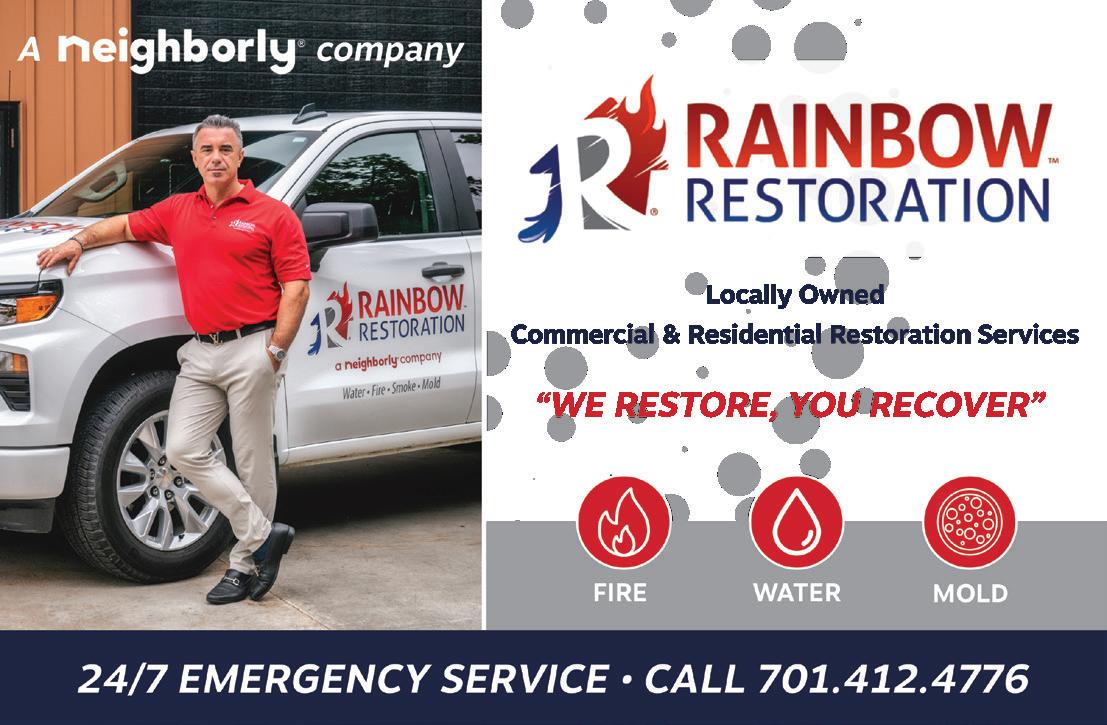
Artificial Intelligence: Where Are We Now and Where Are We Going?
By Doug Sanzone, Veterans Business Outreach Specialist
About the VBOC
The Veterans Business Outreach Center (VBOC) program is designed to provide entrepreneurial development services such as business training, counseling, and resource partner referrals to transitioning service members, veterans, National Guard and Reserve members, and military spouses interested in starting or growing a small business. U.S. Small Business Administration (SBA) has 22 organizations participating in this cooperative agreement and serving as VBOCs.
Not a day goes by without some mention of artificial intelligence or AI. On one side are those who claim that AI will solve all our problems, leaving humanity with little to do other than maintain our technology. On the other side are those who think that AI will take over the world, creating a dystopian existence of humanity serving superior machines or even deciding to end humanity's existence itself.
After spending more than 30 years in the technology field, witnessing its ever-forward evolution, I can unequivocally state the answer will lie somewhere in between those extreme points. AI has been and will be a larger part of our technological toolkit as time goes on. Let's learn some more about AI so we can both embrace the new applications and understand artificial intelligence's limitations.
110 JUNE 2024
Photo Courtesy of VBOC of the Dakotas
D o u g San
ess Outreach Speciali
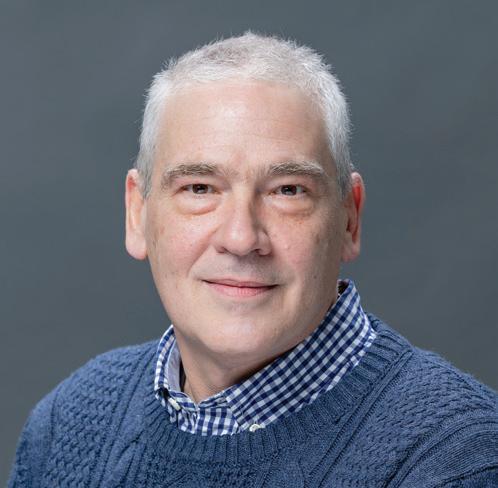
It began in 1763 when Richard Price posthumously presented “An Essay Toward Solving a Problem in the Doctrine of Chances” by Thomas Bayes, an English Presbyterian minister, statistician, and philosopher. This essay laid much of the foundational groundwork that would evolve into Bayesian probability theory, which fundamentally altered our approach to uncertainty and predictive analysis.
Bayes' theorem revolutionized statistical methods by providing a systematic approach to making decisions where both uncertainty and the integration of prior knowledge are important inputs. Bayes heralded a paradigm shift underscoring the significance of prior information in forecasting and the decision-making process. Bayesian statistics are at the core of modern conditional
probability estimation approaches, including probabilistic machine learning, sequential estimation, risk assessment, mapping, and information theory. A theory more than 250 years old is one of the backbones of our current AI craze.
The strategic adoption of AI technologies mirrors the principles of Bayesian inference, where existing knowledge and historical data serve as guideposts for future decisions. This approach gains importance as businesses traverse the complexities of integrating AI products, needing to emphasize the continual refinement of strategies based on emerging data. Let's look at AI as not merely a technology tool but as a strategic asset grounded in principled, datainformed decision-making.

AI's Application
AI’s application already covers a diverse spectrum, reshaping industries in some of the following ways:
1. Customer Service: AI-driven chatbots or virtual assistants can deliver service 24 hours a day, seven days a week, for almost all frequently asked questions.
2. Personalized and Automated Marketing: AI algorithms can analyze customer data to better target email campaigns and other online advertisements or personalized recommendations.
3. Virtual Assistants: AI-driven systems like Siri, Alexa, and Google Assistant can help small businesses manage their day-to-day activities, improving productivity.
4. Automated Bookkeeping: Bookkeeping tasks such as invoicing can now be automated.
5. Data Analysis and Predictive Analytics: Open-source, freemium, or paid AI frameworks and libraries can analyze data quickly and accurately. These insights can help you make more informed decisions across your whole business process, including inventory management, pricing, and identifying customer trends.
Self-driving vehicles, new medicines derived from genomic analysis, and facial recognition are just a few of the new AI-driven technologies. The possibilities seem only to be limited by our imagination and the various
legal challenges surrounding AI. The legal challenges surrounding AI span diverse domains.
Here are some of the legal considerations businesses must monitor to navigate the quickly evolving AI landscape:
1. Intellectual Property and Copyright: Are the works generated by AI eligible for copyright protection and ownership? Was any of the data you used to create it copyrighted? Is there a legal difference between human and AI-generated works? These are all questions that need to be answered and could affect your business if you have integrated AI products.
2. Data Privacy and Protection: AI relies on large datasets for its training and operation. Existing regulatory frameworks such as the General Data Protection Regulation (GDPR) in Europe mandate strict guidelines for data collection, protection, and storage. Violations of these regulations can lead to punitive fines. Businesses leveraging AI must ensure compliance with these regulations, particularly regarding the handling of any personal data and getting user consent.
3. Liability and Accountability: As AI begins making more autonomous decisions, delineating where the liability lies in instances of malfunction or actual harm poses intricate legal dilemmas that have yet to be answered. Identifying culpability
amidst a distributed decisionmaking framework entails establishing legal concepts for what entails negligence, fraud, and product liability. These concepts will take time and legal challenges to evolve.
4. Bias Mitigation: Discriminatory outcomes from an AI model could contravene current civil rights and equality laws. How your AI behaves will expose your business to both legal and reputational risks. Regulatory bodies are focused on enforcing fairness, transparency, and non-discrimination in AI deployment. Make sure you understand the rules so your AI doesn’t violate them.
The adoption of any new technology or process brings along with it the need to develop different procedures for handling contracts and disputes. With time, new and different use cases will be created and put into implementation. These cases will lead to the creation of whole new areas of regulatory and legal structure for businesses to follow.
The need to define responsibilities will be necessary to resolve conflicts among interested parties. Since this is all new, the whole infrastructure needs to be developed. Not only will everyone be dealing with new technology but the rules of the game itself have changed.
Will the framework for the different types of artificial intelligence be a defining characteristic of the legal treatments these products will experience? AI already has
112 JUNE 2024


applications in the creative fields of art, music, and composition, with it still needing to be discovered exactly how to treat such creations.
When implementing probabilistic models that combine multiple decision trees to train a system’s operation, such as a self-driving vehicle, where does the liability lie? How can it be proved whether the software, hardware, or user is at fault in an accident? These are examples of the possible legal issues that will need to be resolved before we can see a full-blown implementation of AI.
There is no doubt that AI and all the derivative software developed over the coming years will transform many of our current business practices. Exactly how things will change and the speed at which these changes will occur is impossible to predict. Though technology moves fast and can do new and useful tasks, the actual adoption of novel technology products is often more difficult than anticipated.
Integrating new processes into older legacy systems takes time and costs. Businesses will only decide to
use these new technologies when they know that the time and effort to integrate them into their existing processes is worthwhile. Until there are policies and procedures for older businesses to follow, the adoption of AI will move relatively slowly. As with any new product or service, once a routine is established, the overall use and speed of adoption will increase.
The implementation of AI products will be much easier for new businesses than the old ones. This may lead to a real competitive advantage for new entries into varying marketplaces. Processes that once took multiple people or systems may now be put together in more efficient structures with the integration of AI products. Without the need to bolt AI to existing business processes but by beginning from scratch, where once the advantage went to the legacy business with legacy processes, the winner may now be the one who can implement the paradigm-shifting power of artificial intelligence most quickly and efficiently. The adoption of our current improved AI may lead to a small first mover creating the next great company.
It is impossible to predict how AI will affect the business world, but we know for sure it will.
VBOC of the Dakotas
701-738-4850
und.edu/dakotasvboc /dakotasvboc @DakotasVBOC
4200 James Ray Dr Grand Forks, ND


114 JUNE 2024
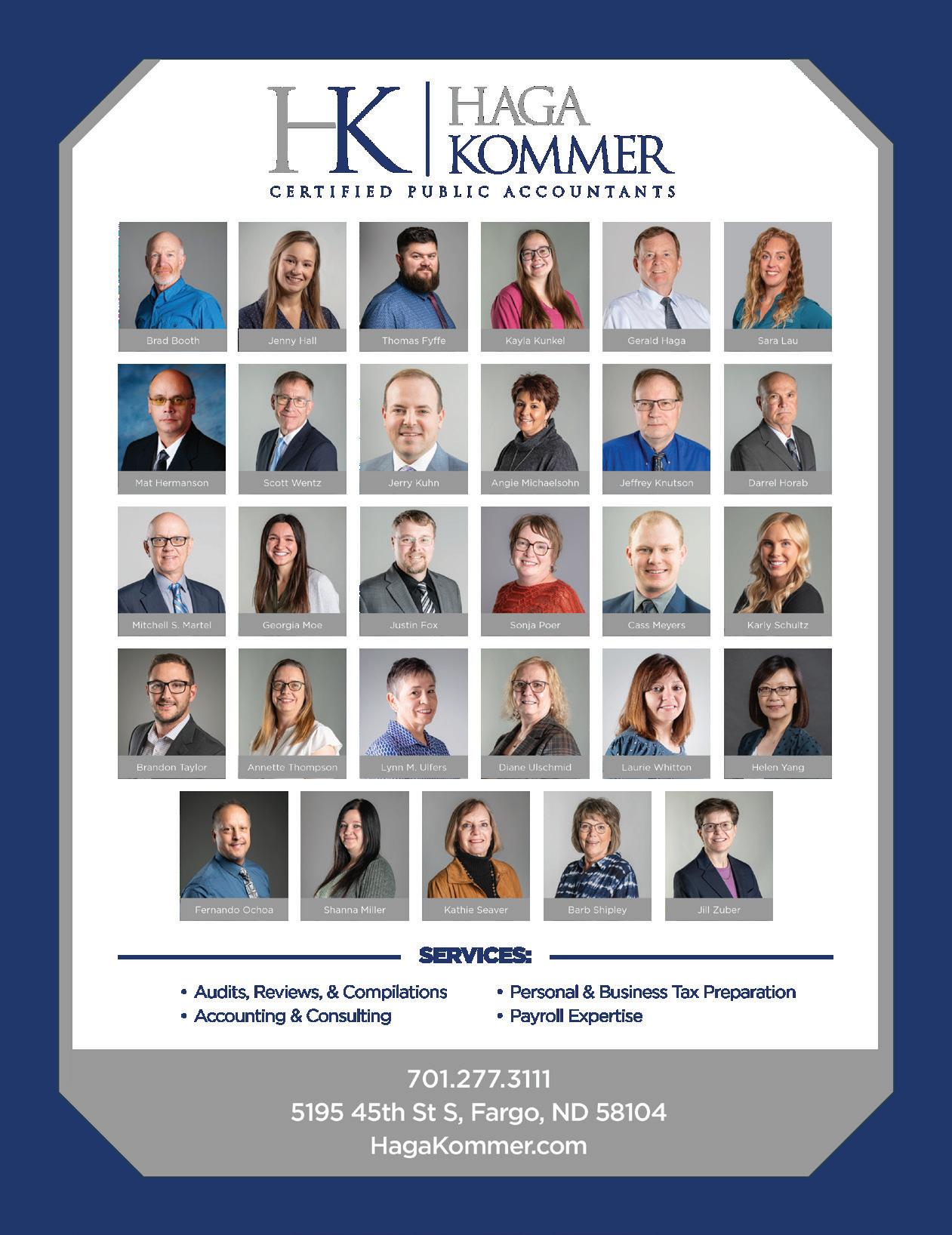
THE ENFORCEABILITY OF HANDSHAKE AGREEMENTS
t's an iconic image of American business. Two people having a conversation about what their company can deliver to the other.
“I can give you this if you can give me that.” This conversation takes place on the golf course, in the field, at a dinner party, on a construction site, or even at a weekend soccer tournament. And all these deals are sealed with The Handshake. The trusting exchange between humans that “my word is my bond.”
Nearly 30 years ago, this trusting exchange was encapsulated in the movie Jerry Maguire. As a refresher, Jerry Maguire is a sports agent who has landed the soon-to-be #1 NFL draft pick in Frank
 BY LEE GROSSMAN
BY LEE GROSSMAN
Attorney, SW&L Attorneys
“Cush” Cushman. Cush’s family wants him to be drafted by the Denver Broncos or the San Diego Chargers. Prior to the NFL Draft, Maguire makes a deal with Cush’s father about Maguire’s representation of Cush as his agent. Cush’s father firmly states that his word is stronger than oak. Maguire then works with Denver to get a promise to draft Cush and a rookie contract offer up to $20 million. On the night of the NFL Draft, Maguire sits down with pen in hand to get signatures from Cush and his family. And in that moment, Mr. Cushman tells Maguire that Cush signed an agency contract with Maguire’s rival, Bob Sugar, an hour earlier.
Now what?
116 JUNE 2024
CREATING A BINDING HANDSHAKE AGREEMENT
Was The Handshake between Maguire and Cushman binding? Are any of these types of handshake agreements binding? Well, like any good legal answer, it depends. A contract may be written, verbal, or even implied. A contract requires an offer by one party and acceptance of that offer by another party. An offer is the promise of one party to perform in exchange for something of value. Merely because a party makes an offer does not create a binding contract. The other party has to accept the terms of that offer. This is where the handshake agreement begins, and often is accompanied by some version of “You got a deal!”
A handshake agreement is enforceable like any other contract if it meets the elements of a contract. A contract requires (1) parties capable of contracting, (2) consent of the parties, (3) a lawful object, and (4) sufficient consideration.
1. Parties capable of contracting. All persons are capable of entering a binding contract except for minors and those who have a mental illness or disability that would limit their ability to understand the terms of a contract.
2. Consent of the parties. Consent must be mutual between all parties. Consent is not mutual unless the parties all agree on the same thing in the same sense. If there is a misunderstanding about the terms of the contract, there is no consent of all parties. This is also referred to as a “meeting of the minds.” Mutual consent is determined by the parties’ outward actions toward each other, not secret or hidden intentions.
3. Lawful object. The object of a contract is the thing to which the parties agree. The object must be lawful when the contract is made and possible to perform. Possible objects include an exchange of money for goods and services, an exchange of work (e.g., “I’ll shingle your roof if you pour my driveway”), or an agreement not to perform certain actions. Impossible objects include illegal services (e.g., the sale of drugs), exempting anyone from their own fraudulent acts, or things that one party does not have the power to give (e.g., land not titled in that person’s name).
4. Sufficient consideration. Consideration is simply something of value, given by one party to the other. A simple transaction where one person gives money in exchange for an item is sufficient consideration. Consideration does not need to be monetary. Anything with value, even something as simple as a pencil, given by the party who lawfully owns it to the
party who is not lawfully entitled to it before the contract is made, is sufficient consideration.
THE STATUTE OF FRAUDS: SOME CONTRACTS MUST BE IN WRITING
Verbal contracts and their terms are just as enforceable as written contracts. However, by law, some contracts must be in writing in order to be enforceable. These contracts fall under the Statute of Frauds.
The Statute of Frauds is a law requiring certain contracts to be in writing and signed by parties. If any of the following contracts are not in writing, any verbal agreements on these matters are not enforceable.
• An agreement that by its terms is not to be performed within one year from the making of the agreement.
• A promise to answer for the debt of another person. Limited exceptions exist for personal and commercial guarantees.
• An agreement to lease property for a period longer than one year.
CONTINED
FARGOINC.COM 117
• An agreement for the sale of real property.
• An agreement for the promise to lend money or extend credit in an amount greater than $25,000.
• An agreement to alter repayment of a debt or forgive some or all of a debt of greater than $25,000.
If the parties make a verbal agreement regarding any of these scenarios, the verbal agreement is unenforceable (with very limited exceptions) unless the verbal agreement is reduced to writing and signed by the parties.
RESCISSION
OF CONTRACT
What if one party later has regret or remorse for the handshake agreement? Parties to a verbal agreement may have the power to rescind a contract. The ability to rescind a contract is limited, though. A party who was induced to enter a contract through duress, menace, fraud, or undue influence by the other party may rescind the contract. Rescission allows the deceived party to restore everything of value received under the contract. Basically, the parties are put back in the positions they were in before the contract was made (the status quo). The consideration and object are returned to the respective parties.
Alternatively, the parties could mutually agree to cancel or terminate the verbal agreement. In this situation, the parties would need another “meeting of the minds” to cancel or terminate the agreement.
UNLAWFUL AND VOIDABLE CONTRACTS
By their very terms, some verbal agreements are unlawful and voidable. They cannot be enforced, even if all the elements of contract formation are met. These include:
• Contracts exempting anyone from responsibility for their own fraud or willful injury to the person or property of another.
• Contracts exempting anyone from responsibility for their own violation of the law.
• Contracts making a contractor liable for the errors and omissions of the property owner or owner’s agents in the plans and specifications of a building contract.
• Contracts imposing penalties for nonperformance of contract obligations.
• Contracts that fix a set amount of damages to be paid for breach.
• Contracts restricting a party from enforcing the party’s rights through a lawsuit.
• Contracts that restrain a person from exercising their lawful profession, trade, or business, except when the restrained person sells the goodwill of a business or when a company is dissolved.
• Contracts restraining the marriage of any person, except a minor.
ENFORCING THE HANDSHAKE AGREEMENT
What if a dispute arises between the two parties? How can a court determine what the terms of the verbal agreement were if nothing was written down? The court looks at several factors:
• Course of dealing. A course of dealing is a sequence of previous conduct between the parties which is used to establish a common basis of understanding for interpreting the parties’ expressions and other conduct. If the parties have an established track record of dealing with each other through handshake agreements, those past dealings will be helpful in determining what the current dispute is about. If one party always delivered a certain type of decorative ceiling tile for interior design projects in the past, the other party could rely on that type of decorative ceiling tile being delivered again at no additional cost.
• Course of performance. A course of performance relates to the conduct of the parties under the specific verbal agreement in question regarding its formation and the parties’ contractual obligations to each other. If one party has consistently delivered a certain brand of fertilizer under the terms of the agreement, that party has an expectation that the other party will not start charging an
118 JUNE 2024
additional cost for that brand of fertilizer.
• Detrimental reliance. One party, to its own detriment, acts consistent with the terms of the verbal agreement. The understanding is that one party would not voluntarily deprive itself of its own property without receiving consideration back. If a subcontractor hangs drywall at the request of the general contractor, the subcontractor would necessarily expect some sort of compensation for the work.
• Usage of trade or industry standard. A usage of trade is any practice or method of dealing having such regularity of observance in a place, vocation, or trade as to justify an expectation that it will be observed with respect to the transaction in question. If a business owner hires a contractor to pour a concrete parking lot, the business owner necessarily expects the contractor will pour the slab in accordance with concrete construction industry standards for the expected use of the parking lot.
• Partial performance. At the time of the dispute between the parties, one or both parties had partially performed their contractual obligations consistent with the terms of the original agreement. If a supplier accepts monthly payments from its customer instead of full upfront payment, the customer has an expectation that the supplier will continue to accept monthly payments instead of demanding the entire balance.
• Complete performance. At the time of the dispute between the parties, one or both parties had completely performed their contractual obligations to
establish the terms of the original agreement. This would show that the parties had a true “meeting of the minds” on the original terms of the handshake agreement.
BEST PRACTICES
Now that you know how handshake agreements are formed and enforced, what should you do when you find yourself involved in one? As an attorney, I often have to recreate the terms of the handshake agreement and the “meeting of the minds” not only with my client, who is one party to the agreement, but with the other party. And when these disputes get to the attorney, it’s often a jumbled mess of memories and “I don’t remember.” The terms always become more favorable to you and less favorable to the other party, as you tend to remember them. But this cuts both ways.
In a perfect world, a handshake agreement is later confirmed in writing. Memorialize the agreement with a follow-up email, text, or any other digital message. Just put it in writing. Ask the other party to confirm if these are the terms. Create a written contract that plainly states the terms and the parties’ obligations. Get everyone to sign the agreement. Our memory of events, terms, and what was said fades over time. Memories and recollections will begin to diverge so put the agreement in writing as soon as you can.
Handshake agreements are enforceable contracts. They are binding on all parties just like written
contracts. The hurdle to enforcement is remembering all the terms the parties agreed to. This may be hard to do in the middle of a round of golf.
Disclaimer: This article is provided for informational purposes only and is not intended as legal advice. It should not be used as a substitute for consulting with a qualified legal professional. No legal services are offered through this article, and no attorney-client relationship is established by reading it. Please consult with an attorney for advice on any specific legal issues you may be facing.
SW&L ATTORNEYS
4627 44th Ave S, Ste 108, Fargo, ND
701-297-2890
swlattorneys.com
/SWLattorneys /company/swlattorneys
FARGOINC.COM 119
AWESOME FOUNDATION GRANT AWARD WINNER
The TELL
ourage? Vulnerability?
Active selfempowerment? The TELL brings individuals together in a community built on sharing personal experiences.
Originating in 2012, the unscripted storytelling event was one of many community gatherings that ended abruptly at the beginning of 2020 with the COVID-19 outbreak. Now, four years later, enthusiasts are looking at a reboot of this unique community experience.
“I was there at the very beginning,” Carol Kapaun Ratchenski, one of the early supporters of The TELL, said “My niece was in town from San Francisco and we were walking around the Street Fair and saw a sign. And we're like, ‘Oh, what's that?’ We literally stumbled in and I'm like, ‘Oh my God, I'm never missing this. This is the best live event in Fargo!’ I just kept going and inviting people to go with me.”
What Carol stumbled into was a monthly event structured around sharing stories that ran the gamut from humor to pathos and back again. Each month had a different theme and attendees wishing to share would put their names into a hat. Names would be drawn and the lucky few were given an opportunity to share about six minutes based on that month’s theme. Examples
included record titles, like “99 Problems” and “You ain’t seen nothing yet.” The direction was simple. The story had to be both true and personal.
“I learned so much about people that you just wouldn't from general conversation, some of them I had known for years,” said Co-organizer Stacy Nicolson, one of the new organizers.
Three judges from the community— including local writers and college professors—would select a winning story for the evening by secret ballot. At the end of a storytelling cycle, a TELLOff would invite the monthly winners to share a final story to determine the overall winner for the year, who then received a small prize.
“Some people were kind of prepared with a story, with a little bit of an arc; beginning, middle, and end. But some would just come and throw their name in the hat,” Carol said. “For example, a good friend of mine would throw her name in the hat every time, without having even thought of a story. She was just like, 'Well, if that's the game we're playing, I'm putting in.’”
While the event is clearly structured, the simple rule of sharing a true and personal story is credited with creating an organic-feeling community environment.
“It’s hard not to care about people when you are like, ‘Oh my gosh, you've been
BY BRANDI MALARKEY, OWNER, IT'S ALL MALARKEY
through all that.’ Or ‘I had no idea you were so funny. I had no idea you did that, as well,” Stacy said.
“It’s definitely community building,” Laurie Baker, another co-organizer said. “It’s the shared sense that we are all imperfect and wonderful.”
“We’ve all really missed that sense of community,” Laurie said. “Since 2020, we’ve talked about it, that somebody ought to do something. Something's missing when you don't have a storytelling event.”
An organizing committee was formed and the group of dedicated volunteers have united to reboot The Tell starting June 13 at a new venue—The Cellar 624, The Venue on Main is located within the landmark de Lendrecie’s building and is an accessible space, beautifully renovated, yet retaining its historic character. The event will be hosted on the second Thursday of the month from 7 p.m. to 10 p.m., with the final Tell-off being held in December. Anyone is welcome to attend and put their name in the hat to share a story if they wish. Each event will also be hosted by a local MC and feature a different local musician each time.
The TELL became the April 2024 grantee of the Cass Clay chapter of the Awesome Foundation by anonymous vote. Awesome Cass Clay had celebrated the end of their first successful year of giving by sponsoring the original The TELL event, one of
120 JUNE 2024

only two official sponsorships in the group’s history. Seven years later, the $1000 grant provided will go toward providing the stage needed to get the event reboot off the ground.
Adults 18 and up are invited to attend one or all of the events and participate if they have a story to share.
“I think most people find it terrifying to share a story,” Laurie said. “And do it anyway. For me, it's really an act of self-empowerment. I think it takes courage for absolutely everybody who gets up there to stand up and share—and it’s also super fun and rewarding.”
“For the event to happen, people have to tell their stories,” Carol said. “I think it’s really generous of people to be that vulnerable.”
The theme for June is “Starting Over,” with “Revolution” to follow for July. For more information check out their Facebook page:
/TheTellFargo
The Cass-Clay chapter of the Awesome Foundation awards a $1,000 gift each month for awesome ideas of all sorts. Grant recipients do not need to be associated with a nonprofit. Applications can be made at awesomefoundation.org/en/ chapters/cassclay.
 Photo submitted by Brandi Malarkey
Photo submitted by Brandi Malarkey
WOMEN YOU SHOULD KNOW


Tiffany Hunt
CHIEF DEVELOPMENT
OFFICER, ANNE CARLSEN CENTER
EMPOWERED BY
122 JUNE 2024
While it might not seem like it at the time, each step along our professional journey helps prepare us for ultimate success. We learn what we like and what we don’t, what we’re good at, and where we could improve. We gain skills along the way and refine our personal definition of success.
Tiffany Hunt, chief development officer for the Anne Carlsen Center, has a very diverse resume, spanning across industries and states. While this collection of experiences might seem disjointed on paper, the wealth of knowledge Hunt gained along the way uniquely positioned her for success in the nonprofit sector.
“I’ve always known I wanted to be of service and help people in some capacity,” Hunt said. “For me, it was easy to take the leap, even between industries, because I believe God has really shown me where I’m supposed to go and when I’m supposed to do it. I just lean into it. Doors have opened and people have literally jumped into my path and made it so obvious where I’m supposed to be.”
Twists and turns
Growing up in a generational farm family, Hunt learned the value of service at an early age. “It was never ‘look out for number one,’” she said. “It was always look out for how you can help other people.”
Right out of high school, she was working as a massage therapist for a local chiropractic clinic, helping treat athletic and auto accident injuries. From there, Hunt explored becoming a child psychologist. But it was her minor in business that really piqued her interest in helping others and making a positive impact.
“I had to take some random business classes because they were required,” she said. “I didn’t intend to like those at all, but the professors just made you want to learn. So, I ended up switching.”
By Arielle Windham |
Like many, she explored retail opportunities while in school. Another thing she didn’t intend to like. However, specializing in engagement ring sales with Helzberg Diamonds allowed her to serve in a different capacity. And she was good at it.
These unique experiences made her something special, as she switched industries again and began working in higher ed.
“I thought, ‘How can I combine my love of hearing people’s stories and wanting to serve and have a purpose,’” she said. “My husband was working at the School of Mines, and they were looking for somebody to do fundraising work. I interviewed for the role, even though I’d never done fundraising before. They took a chance on me, and I was able to do some amazing things.”
It all comes together
Hunt gained more fundraising experience with the NDSU Foundation, and while she was dedicated to the organization and the school, she felt there was more she could be doing to serve her community. When an opportunity with the Anne Carlsen Center came up, she couldn’t help feeling called.
“I have family members who have disabilities and developmental delays,” she said. “Connecting with that mission on a very personal level made it easy. Providing services to these children and their families from birth changes the trajectory of their whole life.”
For Hunt, working with the Anne Carlsen Center finally feels like her personal definition of success. She’s able to use the wide range of skills developed over her diverse employment background to serve a deserving community. Each stepping stone, from her early career in massage therapy to retail and fundraising, has paved the way for personal and professional fulfillment.
“I love being able to help other people, whether that's through managing teams or inspiring philanthropic gifts to an organization that, in turn, helps children,” Hunt said. “There were times I wasn't sure that I could do it, but all the signs were saying this is what you're supposed to do. And I’m a firm believer if somebody gives you the opportunity and you don't know how to do it, take it and then figure it out when you get there.”
A bright future
The Anne Carlsen Center is currently preparing for a busy summer. The organization recently completed the move to the state-of-theart Ballantyne Berg Campus in Jamestown. The campus serves as the new home of Anne Carlsen Center’s comprehensive array of educational services, outpatient therapies, residential care, and more.
Hunt and her development team played a major role in funding the new facility and they can't wait to welcome the community during the celebration and grand opening event on June 6, starting at noon. For more information, visit the organization’s event page at annecarlsen.org/ events
Learn more about the Anne Carlsen Center and how you can join Hunt in helping others enjoy greater independence and quality of life at annecarlsen.org/careers.
“I think if you really want to impact the lives of others in a really positive way, then this is the organization to do it,” Hunt said. “There are so many different avenues to serve, whether you want to work with early intervention, special education, nursing, or physical therapy, there are a million ways to do this job and impact people's lives in a positive way.”
FARGOINC.COM 123
Photo by Anne Carlsen Center
10 Questions
10
Questions
ohn Machacek, Chief Innovation Officer for the Greater Fargo Moorhead Economic Development Corporation, has worked with countless startups throughout our community over the years. He knows their ups, and their downs, but most of all, he knows the questions to ask them. Here are John Machacek’s 10 questions for Tate Howe, Founder, Get Coffee'd.
By John Machacek
 Kopp
Photo by Josiah
Kopp
Photo by Josiah
124 JUNE 2024

01
Will you please tell me your Get Coffee’d elevator pitch?
Our cold-brew-infused hard chews satisfy the Mocha Latte taste you crave while instantly delivering 48mg of natural caffeine for that wide-awake, ray-of-sunshine energy you deserve. Experiencing a tough commute, long flight, or an afternoon slump? Get Coffee’d lets you take your cup of joe on-the-go. No spills, no lines, no misspelled names. Just real cold-brew coffee with real natural caffeine—in a real tasty chew.
We’re all just energy, but sometimes we need a little more—GET COFFEE’D.
02
How long have you been working on the development of this product?
I began thinking about the concept a decade ago but started placing focus on it about two-plus years ago. After being at Dot’s Pretzels, I vetted some new roles around the country, but nothing felt right or got me excited. Throughout my time at Dot’s, I was surrounded by amazing individuals who provided the opportunity to gain the necessary knowledge to take Get Coffee’d from concept to a viable product—and all things told me that Get Coffee’d was a solid item.
Mentally, as I would revisit the Get Coffee’d concept, I would actually try to convince myself it wouldn’t work. However, my gut said otherwise so I shooshed that little voice and got to work bringing it to life.
FARGOINC.COM 125
10 Questions
I’m curious, how has the process gone to formulate something like this, and iterate on it?
Two steps forward, six steps back, more steps forward. Rinse and repeat. To say the least, it’s been a journey.
Coming from the “Salty Snack” category, the one thing I didn’t learn at Dot’s was how to formulate or cook a confectionery. So, it started in the kitchen, and like all things, you learn little by little and the entire time you think you’re crazy for even beginning. Throughout the journey, I’ve been blessed by a lot of helpful individuals who believed in the vision. Cooking a confectionery is a finicky process and not a forgiving one. It took a hundred attempts to create an edible product, and it took another couple hundred attempts to create a product that’s ready for the market. You don’t have the liberty of making more than one tweak at a time, so it takes a lot of time to make those adjustments. The product has come a long way, but we feel confident in the end result.
04
So, formulating the recipes and the tests is one thing, but then manufacturing larger amounts is another thing. How have you gone about producing and packaging the candy?
Initially, the plan was to outsource manufacturing. However, I learned quickly that wasn’t going to happen. After vetting out potential manufacturing options around the country, it became clear it was time to pivot and to find the necessary equipment to take manufacturing in-house. So, I hit the road and visited numerous confectionery and packaging equipment manufacturers until I found the correct components necessary for our application. Once I found what I hoped to be the correct equipment, I leased a small R&D manufacturing space to practice and ensure what I believed would work, actually did. After months of learning and using the equipment, it was finally go-time, so we picked up everything and moved it into the original Dot’s Pretzel plant in Velva, ND.
05
I think it is awesome that the manufacturing of your product is happening in Velva, where Dot’s Pretzels were once produced. Can you tell me more about the move to Velva, as I’d love to hear about that?
North Dakota, in all areas and for endless reasons, is an amazingly supportive and business-friendly state. The company was registered here from the start—the plan was always to be in ND. With that, something I will never be able to show my true gratitude for is all the great people here in ND that have helped along the journey.
Oddly enough, my first contact here was you, John. It’s been over a year since we first connected while I was searching for a location to set up shop. From there you’ve acted as the snowball that doesn’t stop by instrumentally connecting me with key individuals and helping me navigate through the plethora of opportunities the state offers. Whether it’s been Josh, Shayden, Kevin, or Maria from the North Dakota Department of Commerce, the O’Leary Ventures team, Sadie and
. 03
126 JUNE 2024
Greg from Emerging Prairie, Greg from Minn Dak Market, our Velva Mayor Mike, our local Velva Banker David, our distribution partners at Bischof Distributing, or the amazing retailers around the state—each and every one of these organizations and people have welcomed us with open arms and made us feel like North Dakota is home.
With all that said, last year when we first met, the “where” we were going to set up in North Dakota had not presented itself, yet. Again, early on, prior to renting space in Minnesota, I looked at various buildings around North Dakota, but couldn’t find a good fit for our needs. So, I kept moving forward and had faith that something would come about—and that something was Hershey’s pulling out of the Dot’s Pretzels plant in Velva.
As heartbroken as Dot, the team, the State, Velva community, and everyone else including myself was that Dot’s Pretzels was leaving the state, I took it as a gift. The perfect gift. Dot and Randy Henke are partners with me and still own the building. The building was designed for manufacturing, and the old team was looking to get back into action. I will forever be grateful and indebted to Dot and Randy for what they’ve done and continue to do for me.
06
How has your experience working for Dot’s Pretzels helped you in this startup process, whether it be creating the product and/or developing a product plan and/or your distributor and retailer network, or whatever else?
My time with Dot’s Pretzels was priceless. The Dot’s ride and experience was like getting an MBA in all things food manufacturing, and sales and distribution. Hindsight is a crazy thing; I will never forget the first day I met Dot in 2017 at the plant in Velva. That team— our CEO, Randy Johnson; the leadership team; the production teams—every single individual there was part of taking a dream from Dot’s kitchen and growing it into the number one pretzel on the planet.
07
So, let me shift gears to think about the finished product. First of all, your packaging is very interesting and clever. Will you please tell me about the thought process behind the package design?
The initial thought process was to have packaging that could be carried around in your pocket for easy access to onthe-go energy. I also wanted packaging that would resonate well with the coffee category and our branding, but something that created differentiation. There are many things to think about and metrics you want to consider as you develop your packaging. You want to look at it from a costing perspective, production perspective, supply chain perspective, from a merchandising perspective, and finally the end perspective—the shopper’s perspective.
Everyone is familiar with a paper coffee to-go cup and our graphic designer is a genius. So, we married all of the above together and you can see the final result at our website getcoffeed.com
FARGOINC.COM 127
10 Questions
08
Then, secondly on the finished product, what or where is your plan to roll these out, as far as geography and selling channels?
Our initial focus is on North Dakota. We have an amazing North Dakotabased distribution partner that will be instrumental in gaining space at all channels of trade: grocery, convenience, and many non-traditional accounts. We also have a distribution set up in Kansas, Montana, South Dakota, and Minnesota. While our distributor partners are out hitting the streets, we will be working on getting our website set up for direct-toconsumer. The goal is to saturate North Dakota, then the states I just mentioned, from there we will have learned the necessary information pertaining to our item and our consumer to be more intentional with our growth and expansion strategy. There’s a big difference between creating a product and building a brand. Building a brand that is accepted in the marketplace takes time and it takes repetition of simple marketing concepts like trial and awareness.
09
If you could go back in time to Tate from several years ago, what hindsight advice would you give yourself?
To be kind to yourself, keep the faith, and don’t take anything too seriously. We’re only here for a moment, have fun, and make mistakes.
10
As a last question, I always ask, what can we do as a community to help you and Get Coffee’d succeed?

We would love the community’s support. As you’re venturing around North Dakota, you’ll start seeing Get Coffee’d popping up at your local grocery store, convenience store, sporting goods store, hardware store— or at any store that will talk to me.
Try our item, buy our item, and share our item. And if you don’t like our item, keep it to yourself—kind vibes only. No, but actually, with that said, feedback both positive and negative is appreciated, as that’s how we get better.
Feel free to send any and all thoughts to ContactUs@getcoffeed.com
Also, if you feel that you’re meant to join the Get Coffee’d journey, send us a note, and let’s connect.
getcoffeed.com
About John
128 JUNE 2024

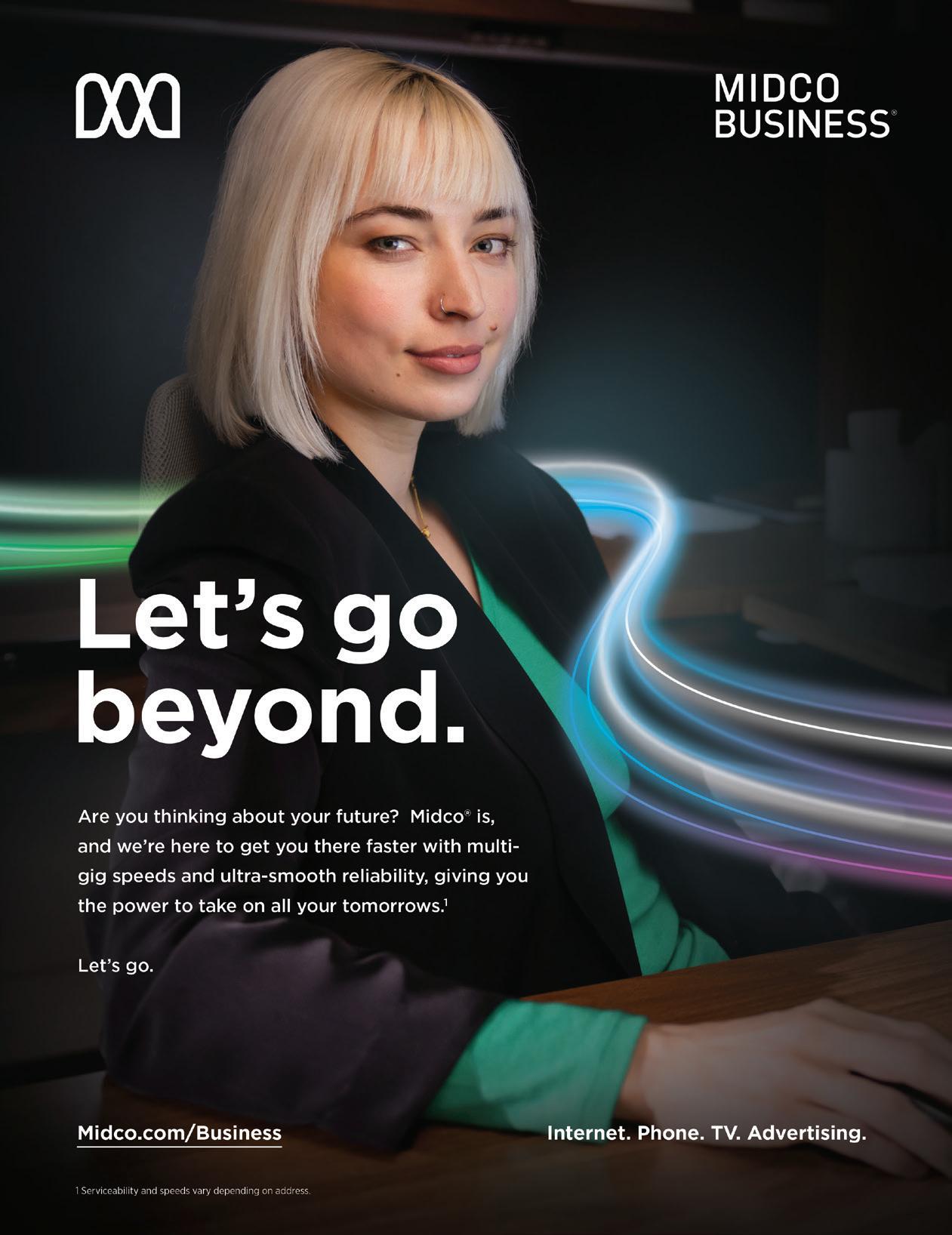






























 Brady Drake, Fargo INC! Editor
Brady Drake, Fargo INC! Editor




































































 JERRY BENTS
Fargo Office Manager
JERRY BENTS
Fargo Office Manager


 By NorthStar Technology Group
By NorthStar Technology Group








 By Brady Drake
By Brady Drake
By Brady Drake
By Brady Drake






 By Brady Drake | Josiah Kopp
By Brady Drake | Josiah Kopp














 ST. PAUL NEWMAN CENTER
ST. PAUL NEWMAN CENTER










 By Brady Drake | J. Alan Paul Photography
By Brady Drake | J. Alan Paul Photography










 By Brady Drake | submitted by Jay Nelson
By Brady Drake | submitted by Jay Nelson


















 Eric Smith
Eric Smith














 A peek at the Pinterest pins that started the design process!
A peek at the Pinterest pins that started the design process!



 These are some of the AI-generated images that Jeff created while narrowing down the exact vision of the graphics!
The final designs for the 2024 TEDxFargo event, "If."
These are some of the AI-generated images that Jeff created while narrowing down the exact vision of the graphics!
The final designs for the 2024 TEDxFargo event, "If."







 By Brady Drake | Josiah
By Brady Drake | Josiah








 Leah Petersen, Architect
Leah Petersen, Architect









































 BY LEE GROSSMAN
BY LEE GROSSMAN

 Photo submitted by Brandi Malarkey
Photo submitted by Brandi Malarkey


 Kopp
Photo by Josiah
Kopp
Photo by Josiah



